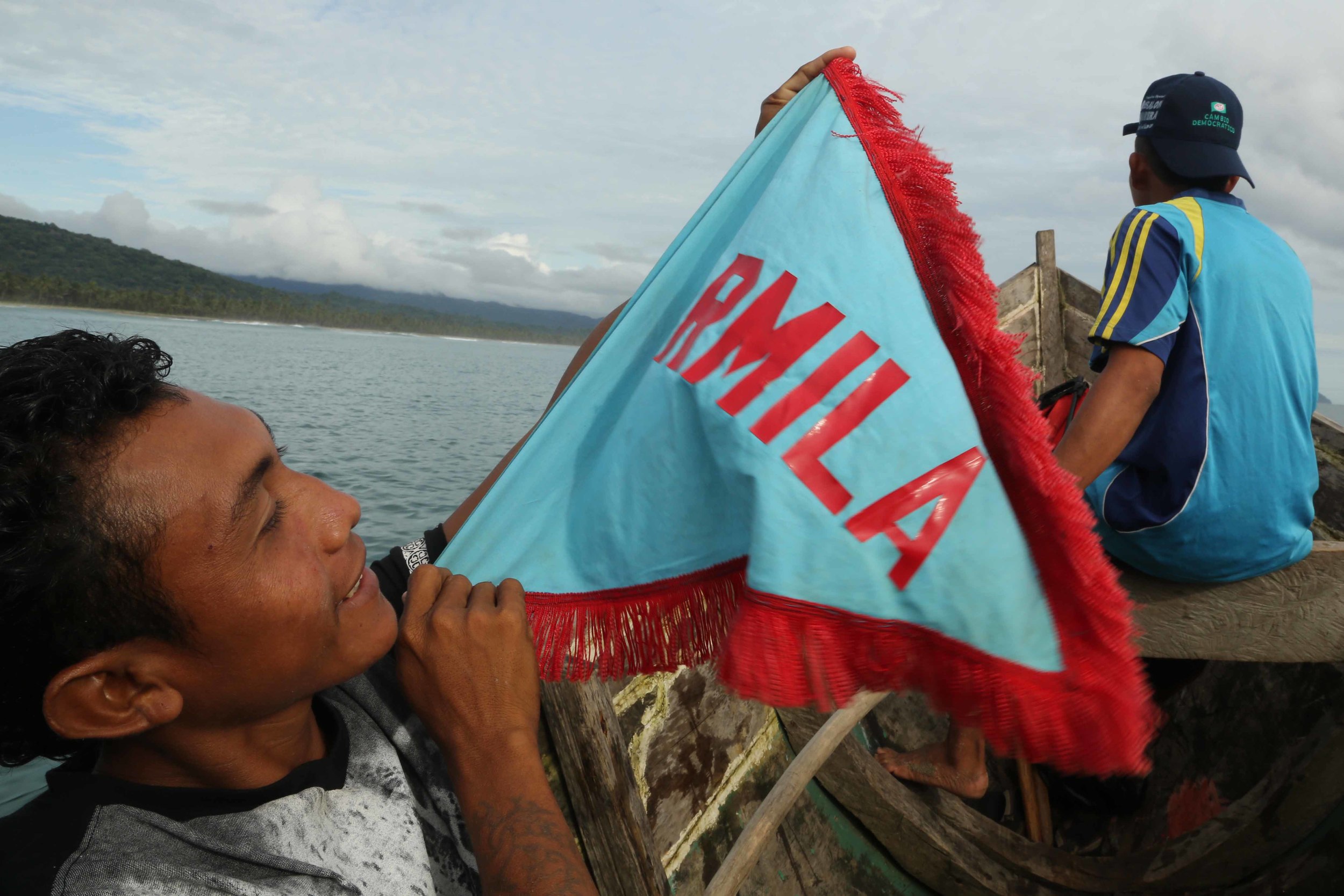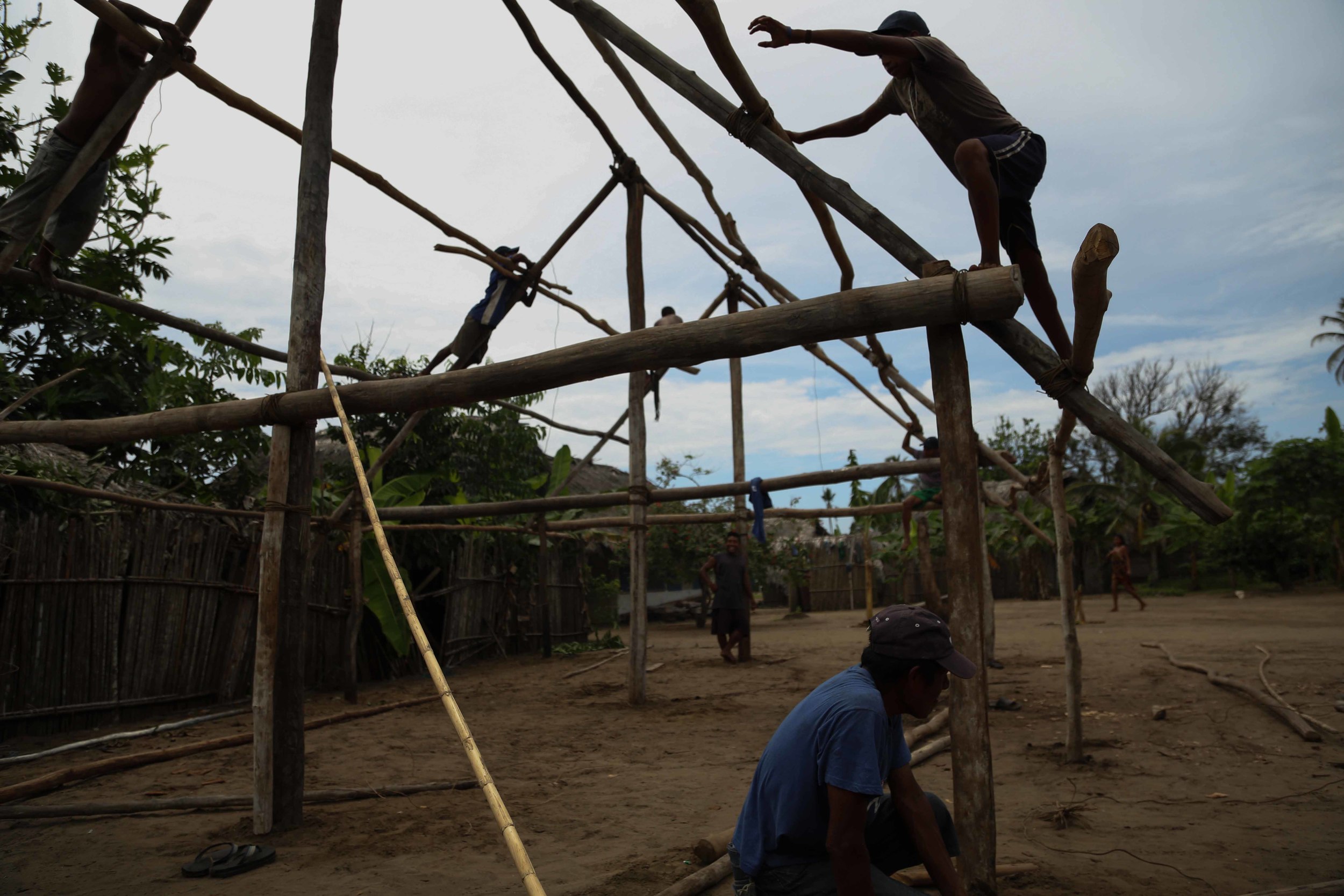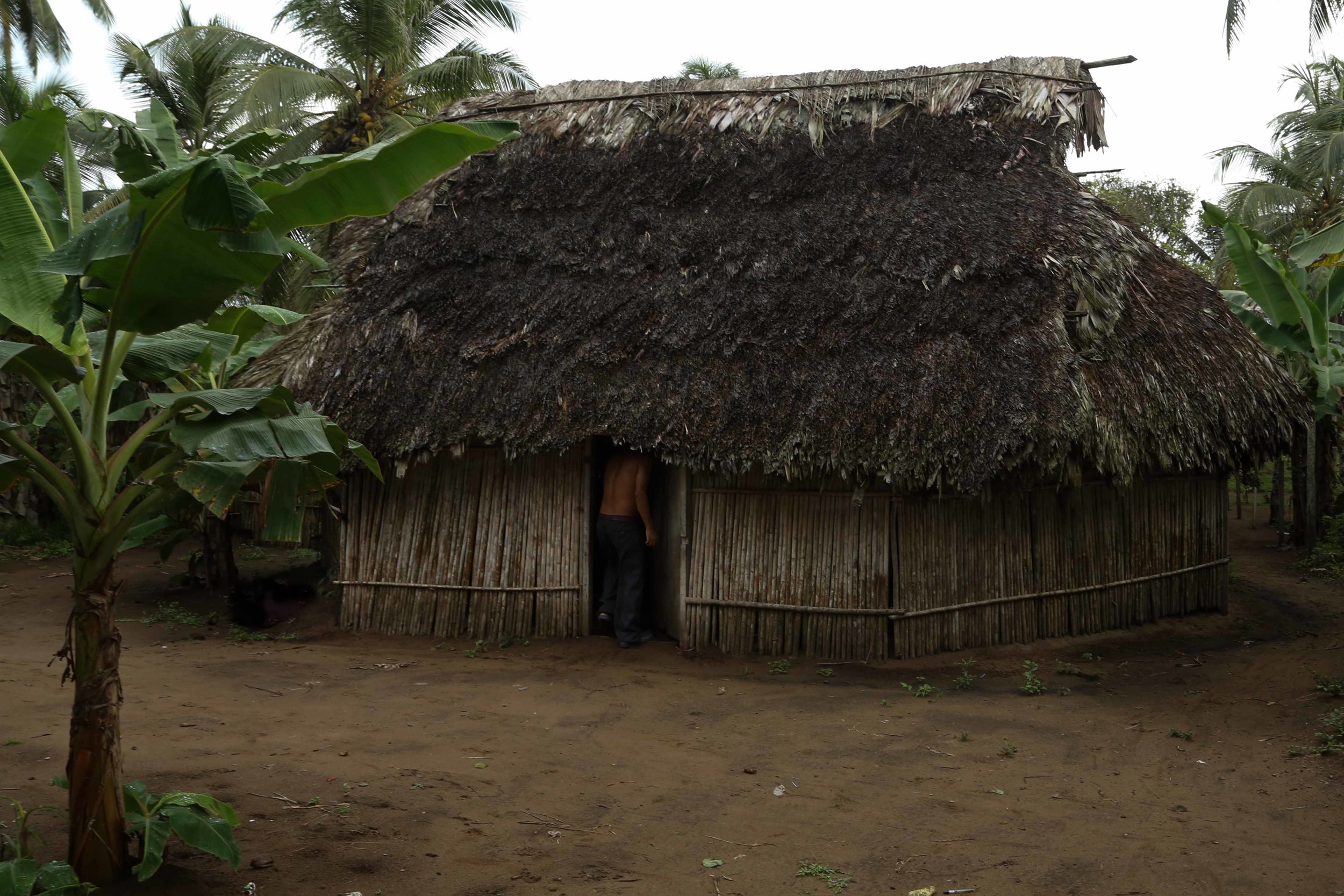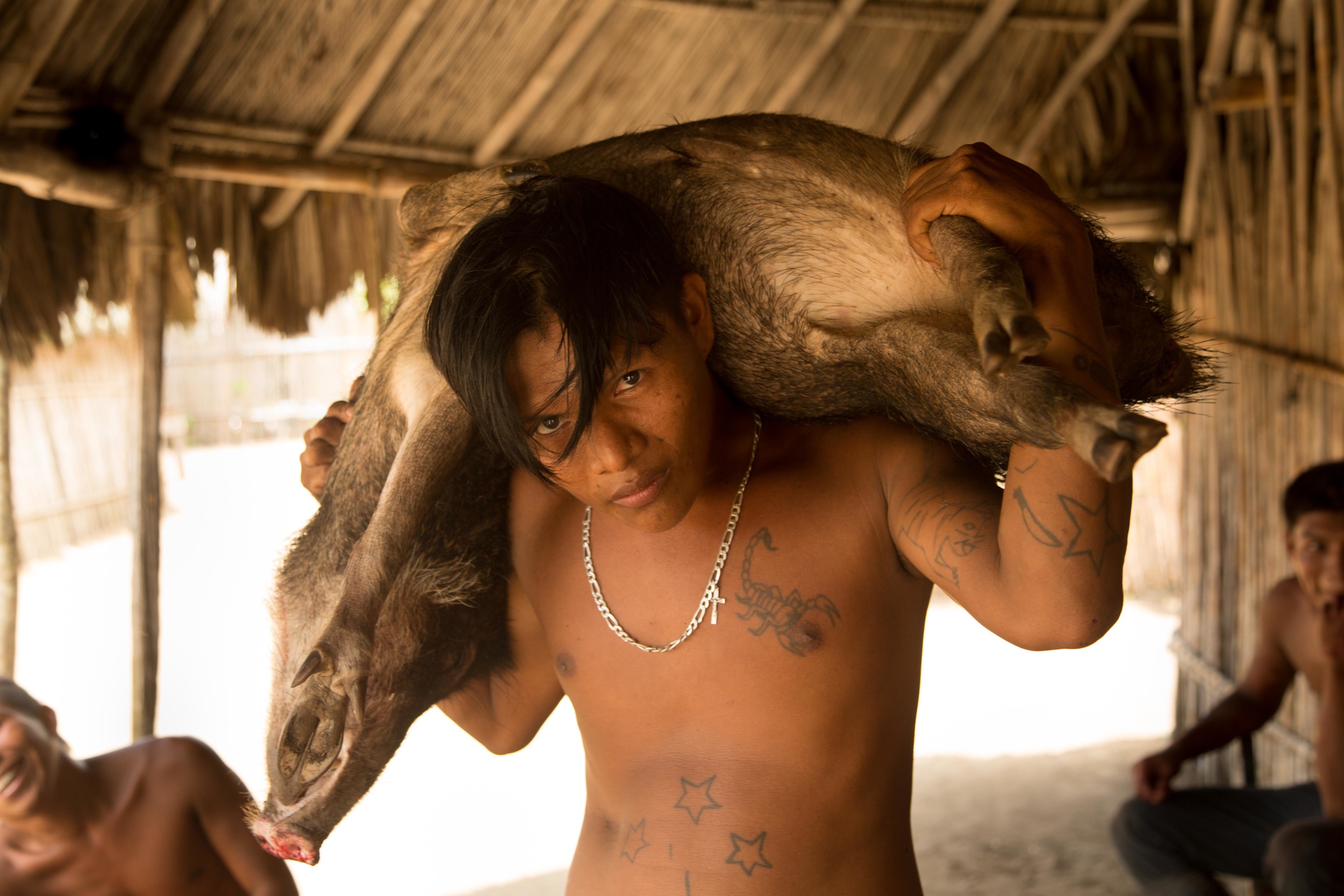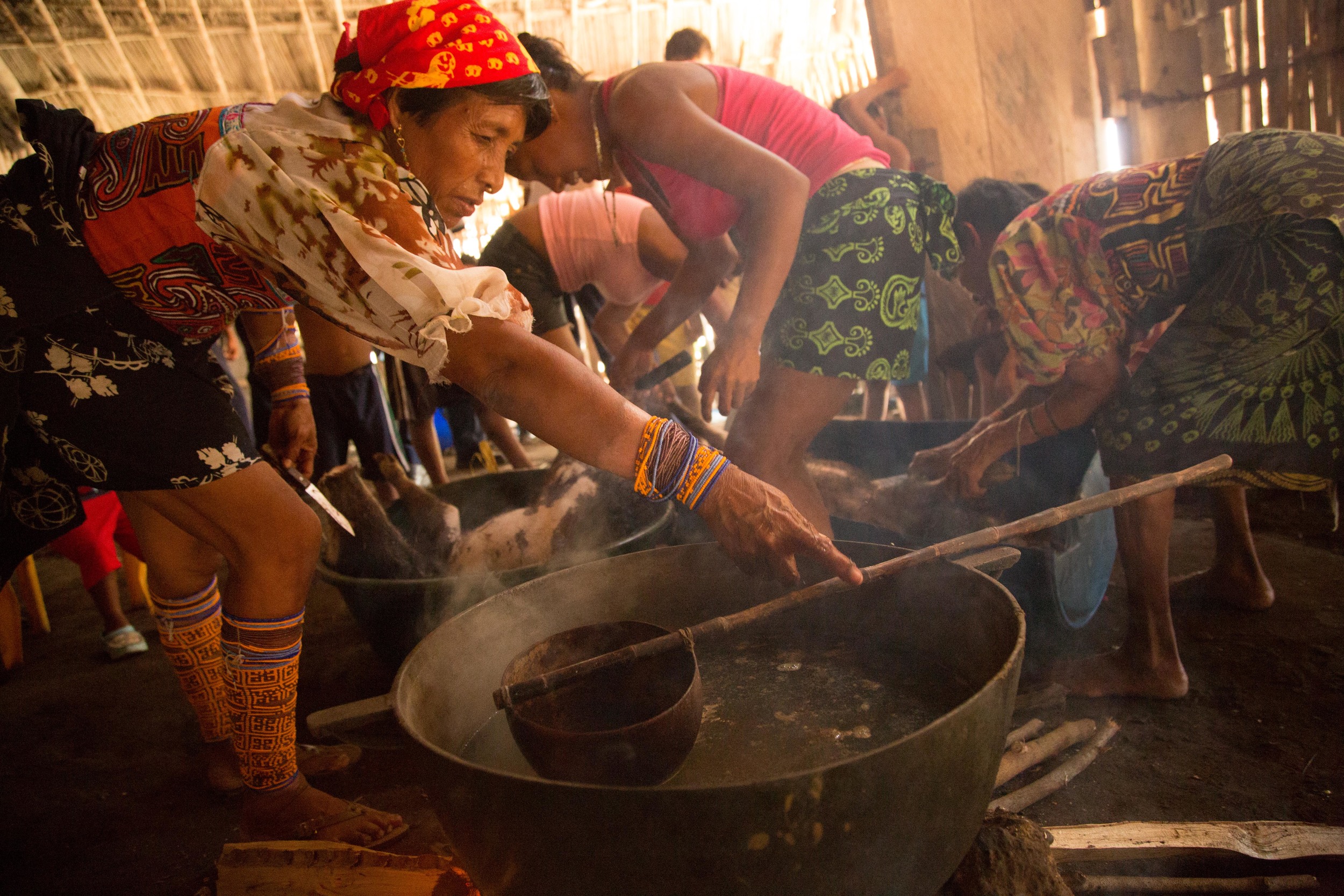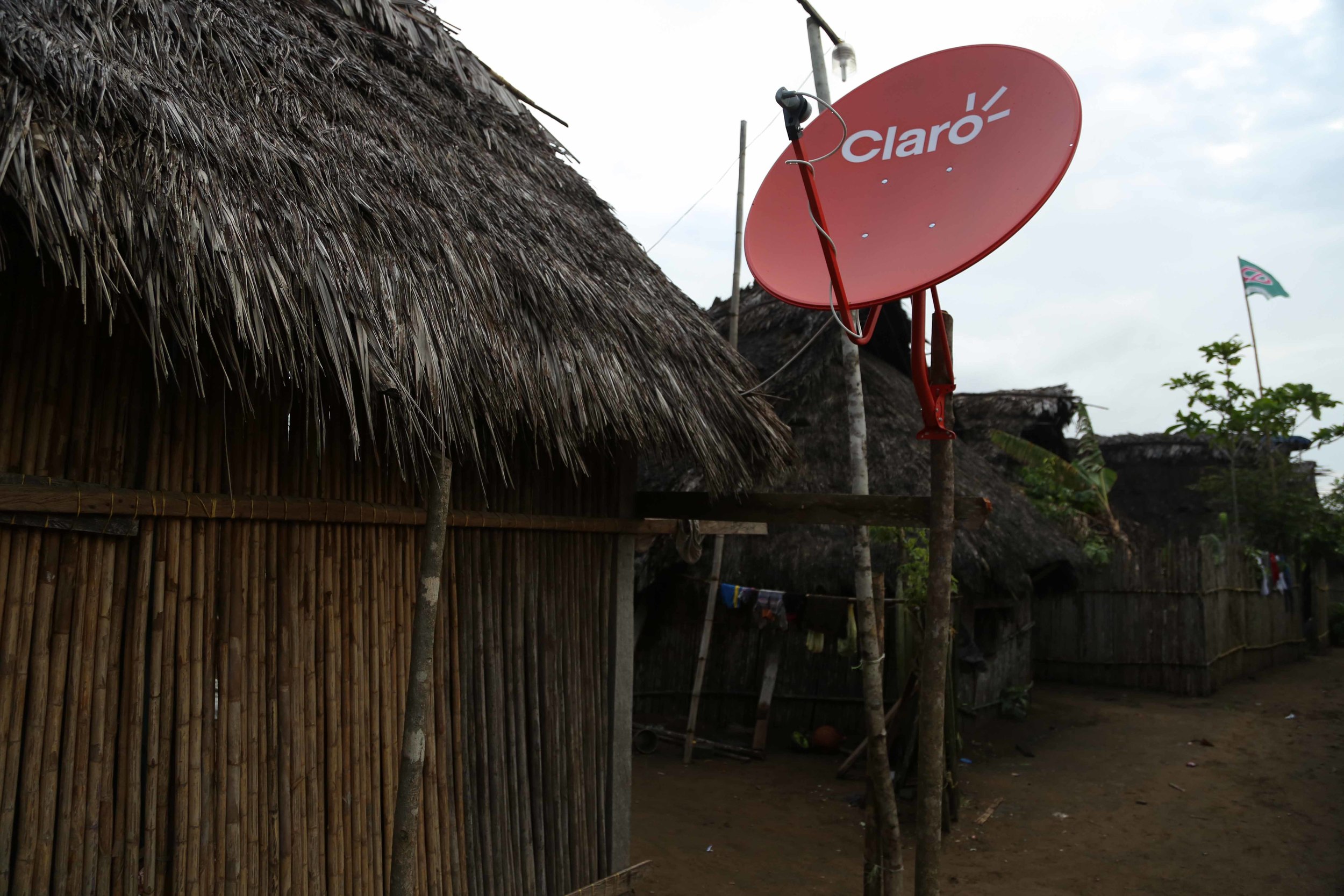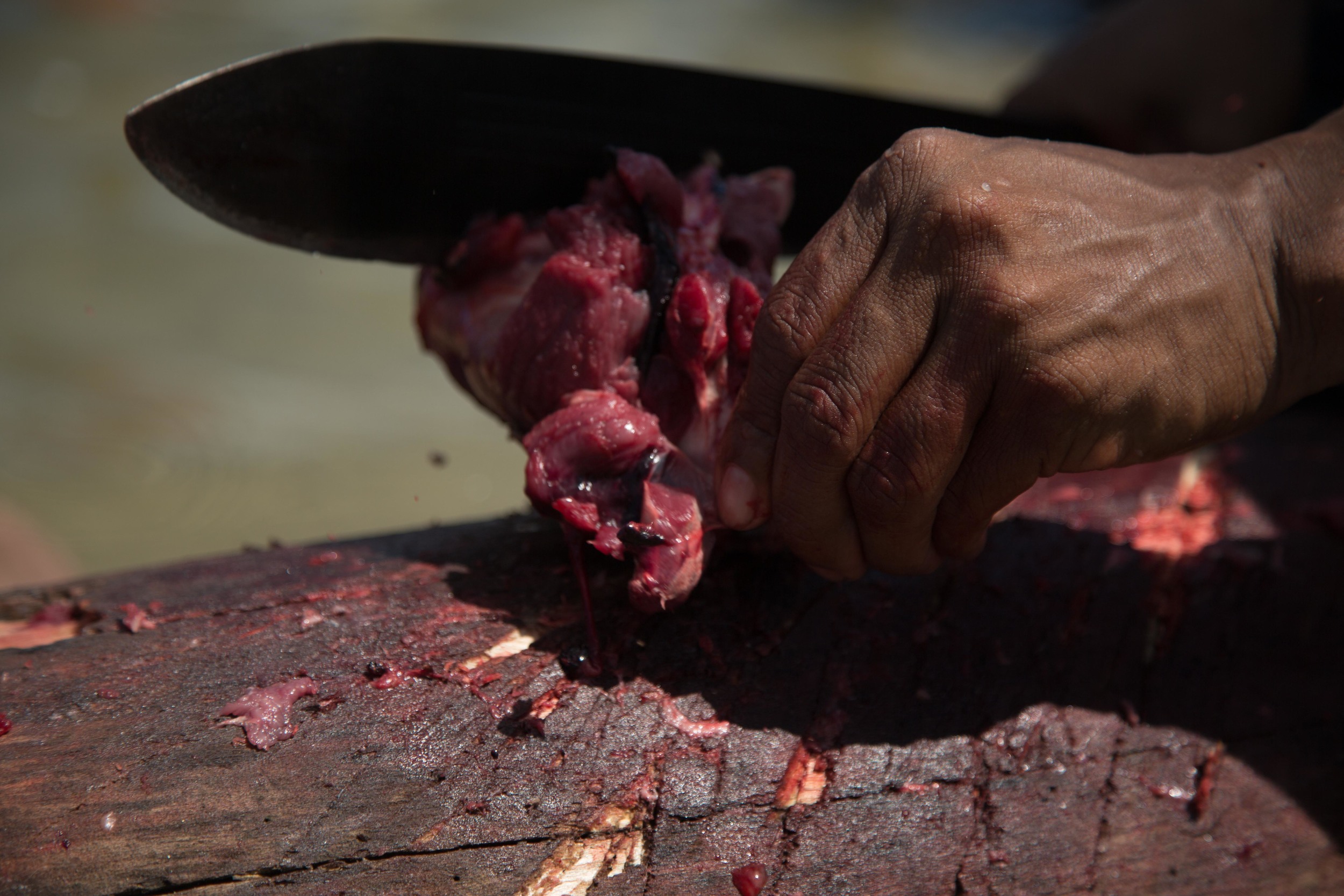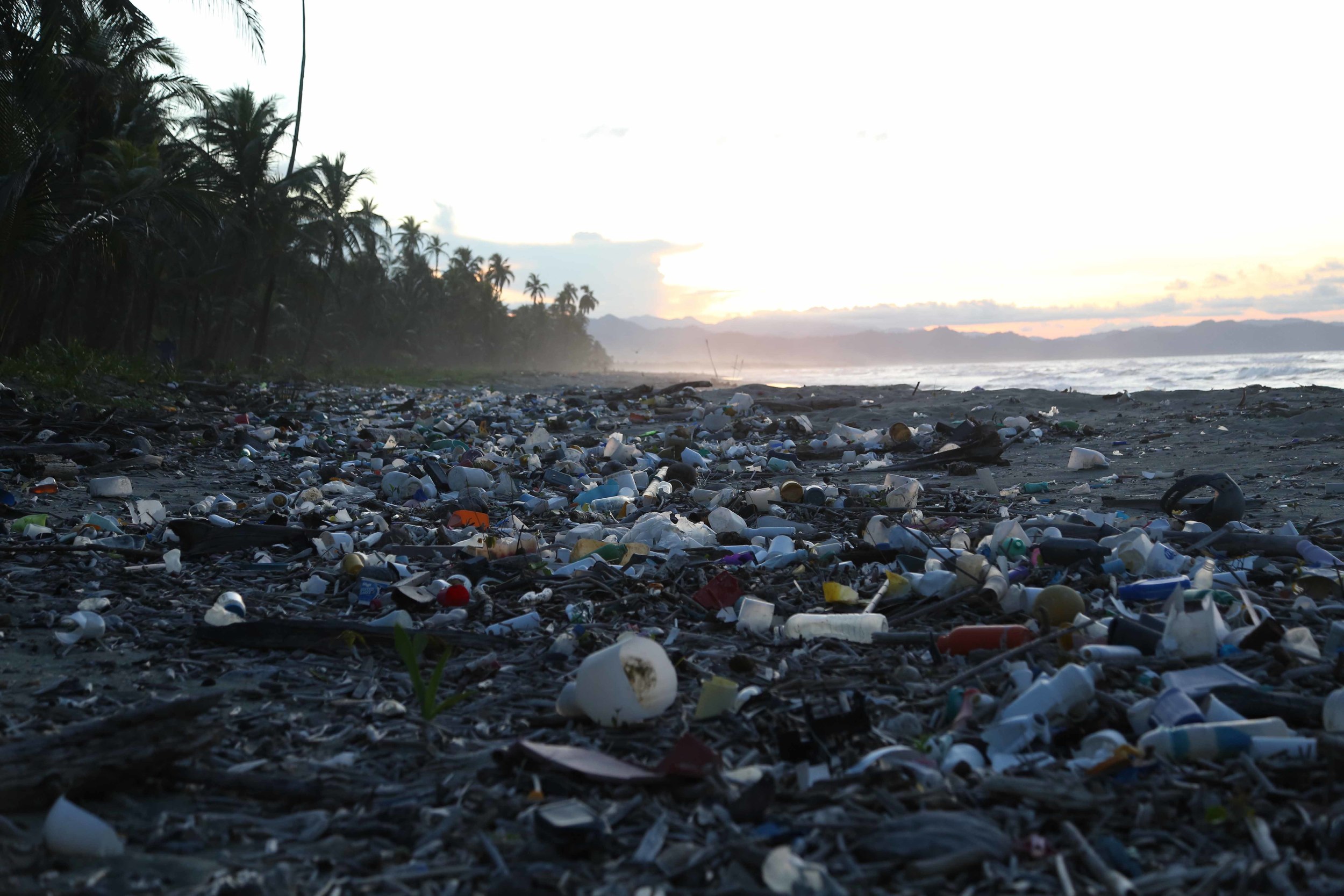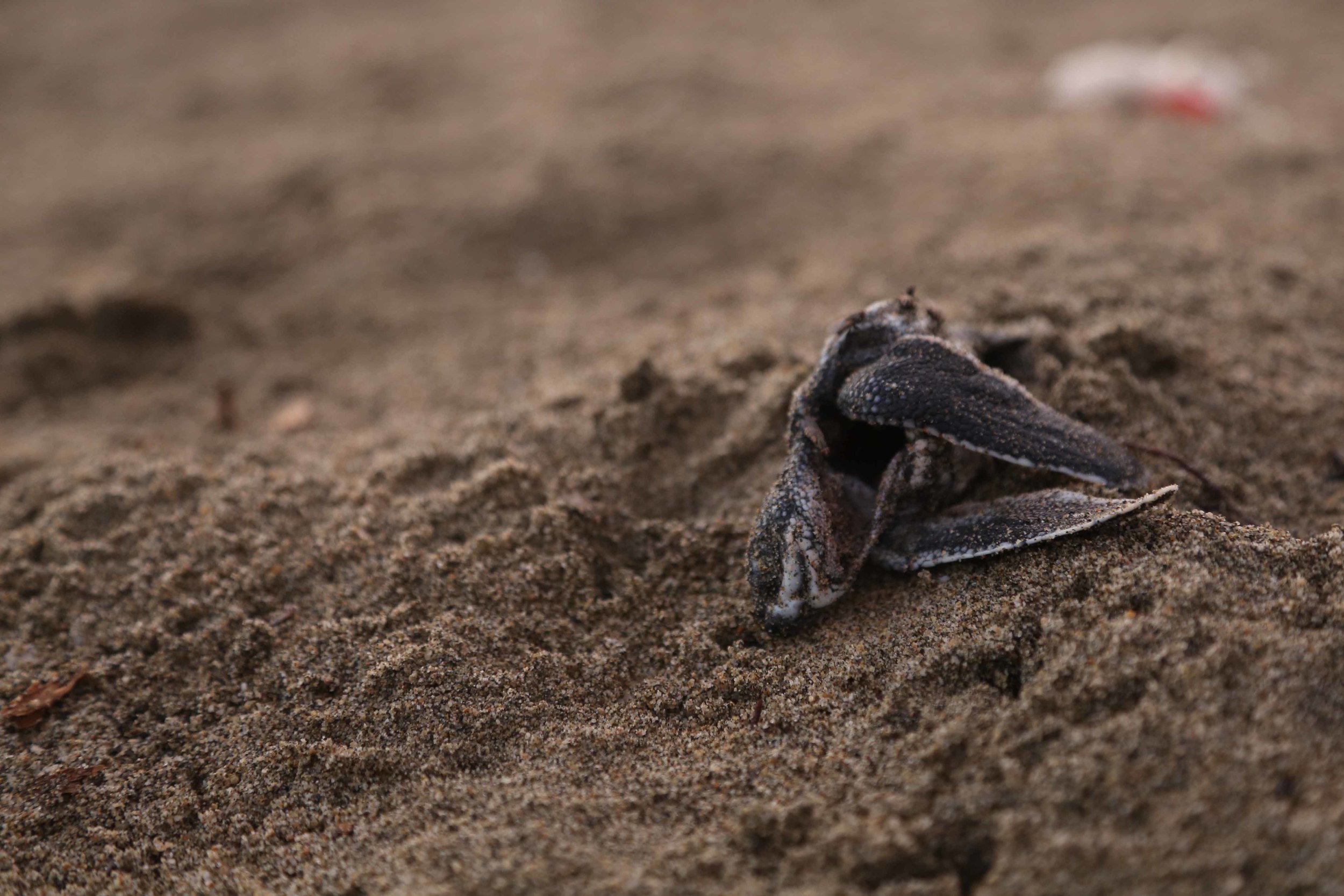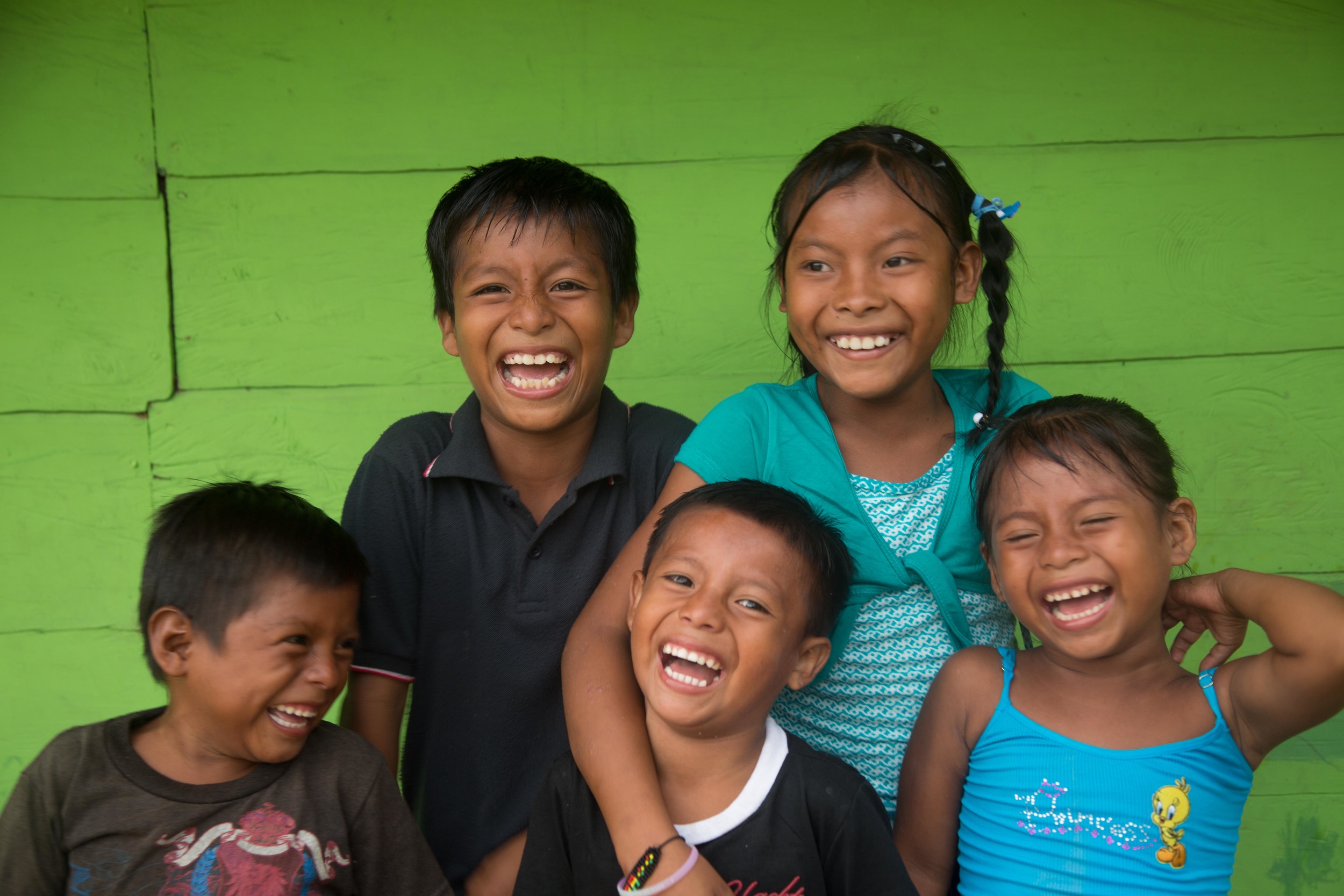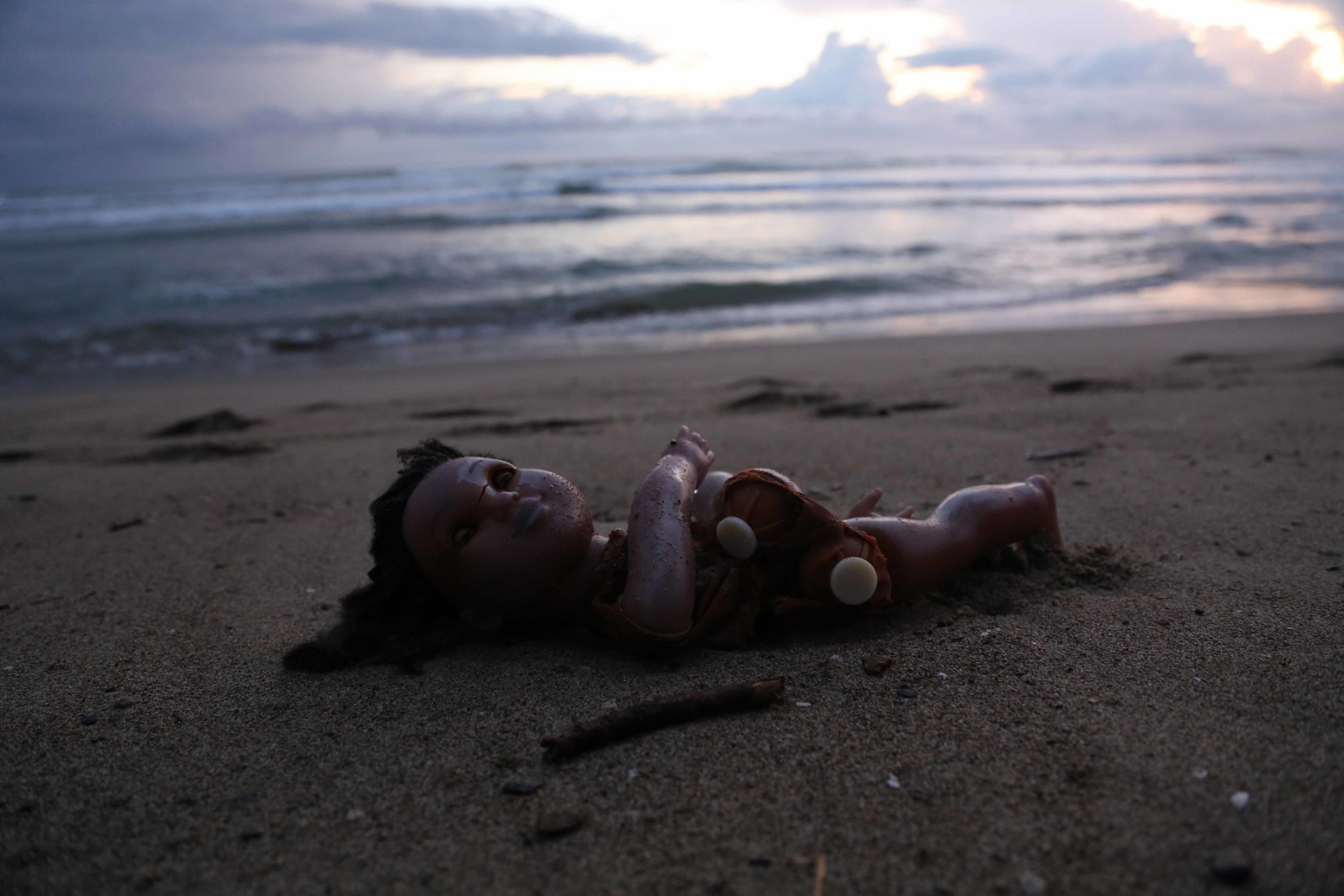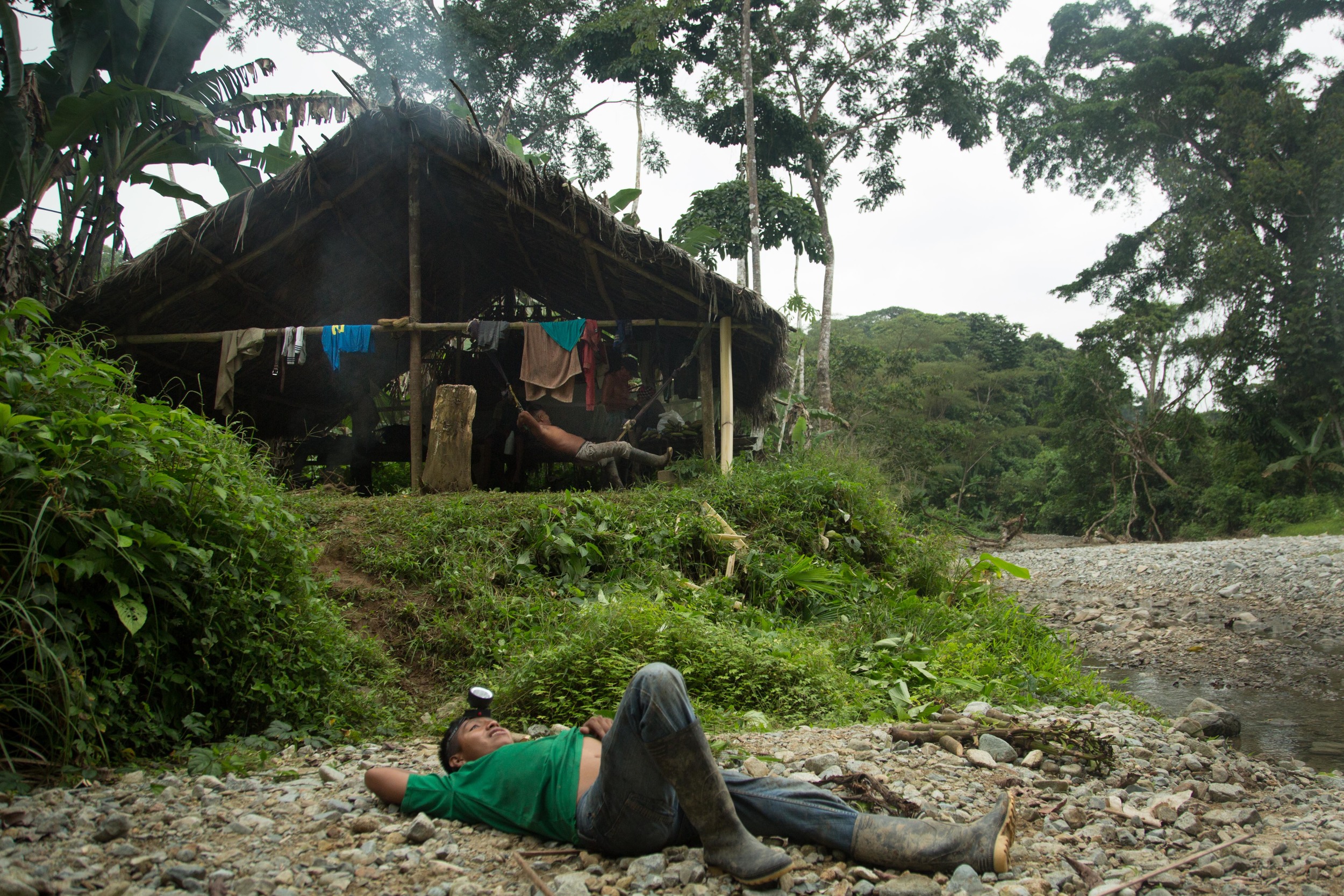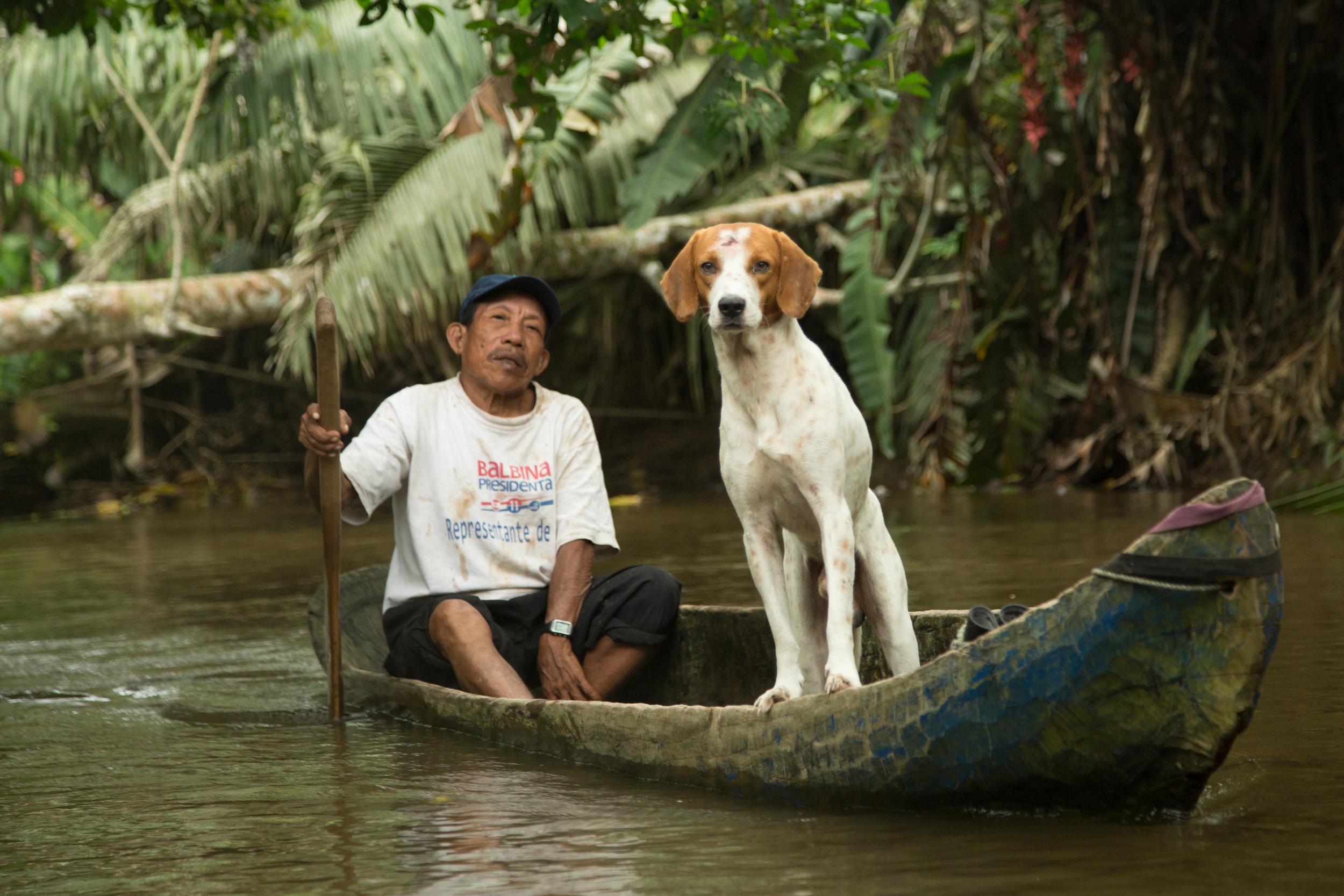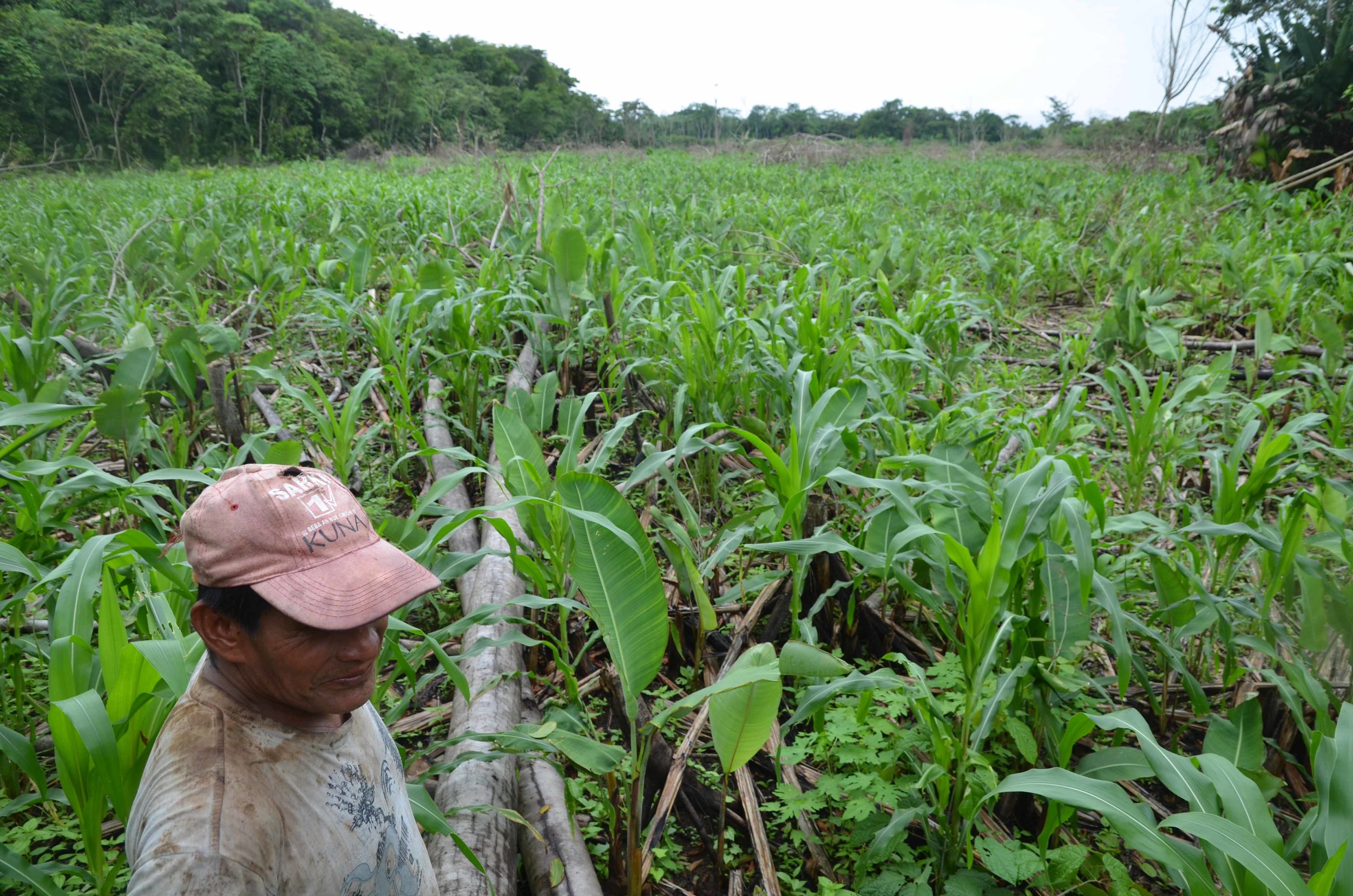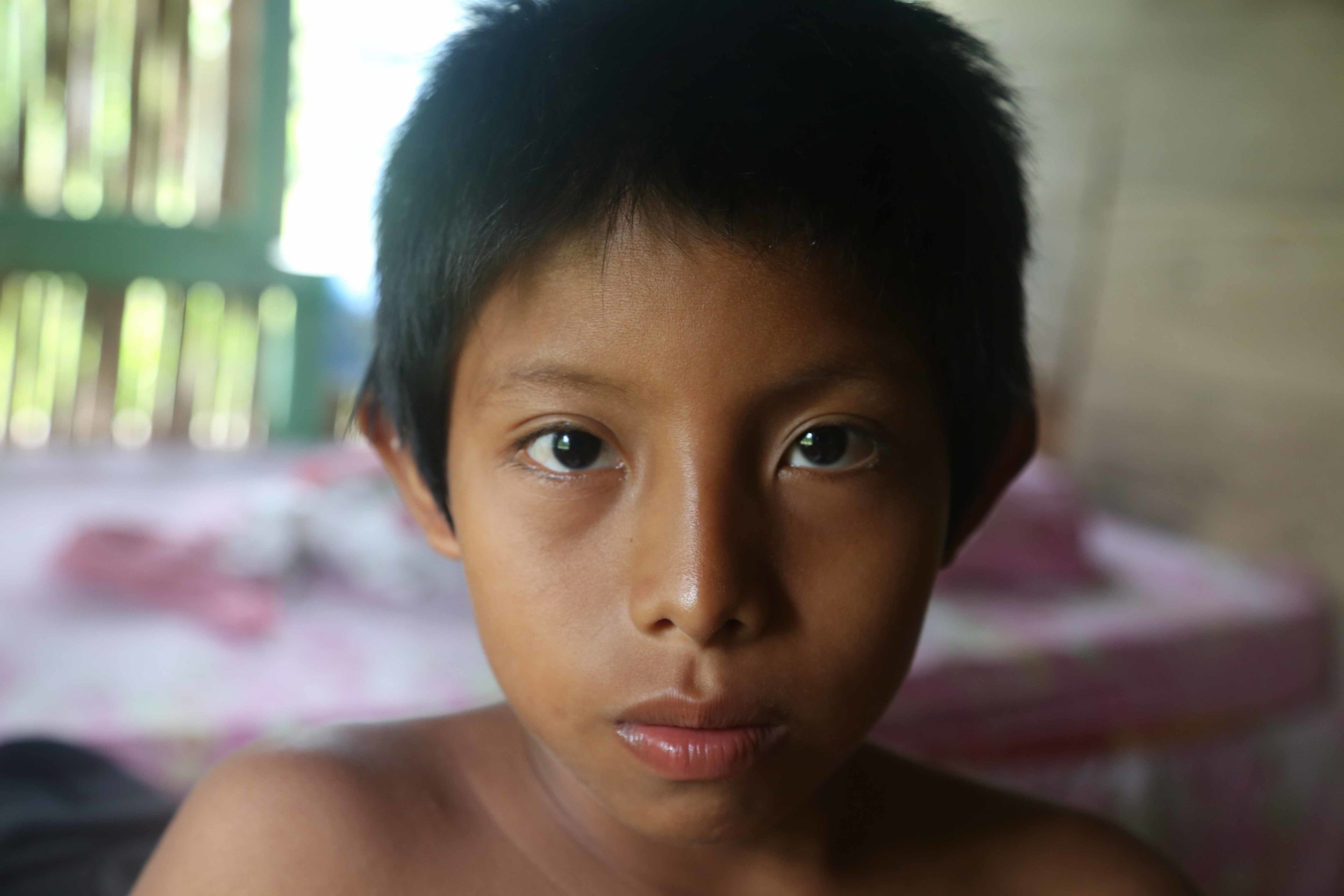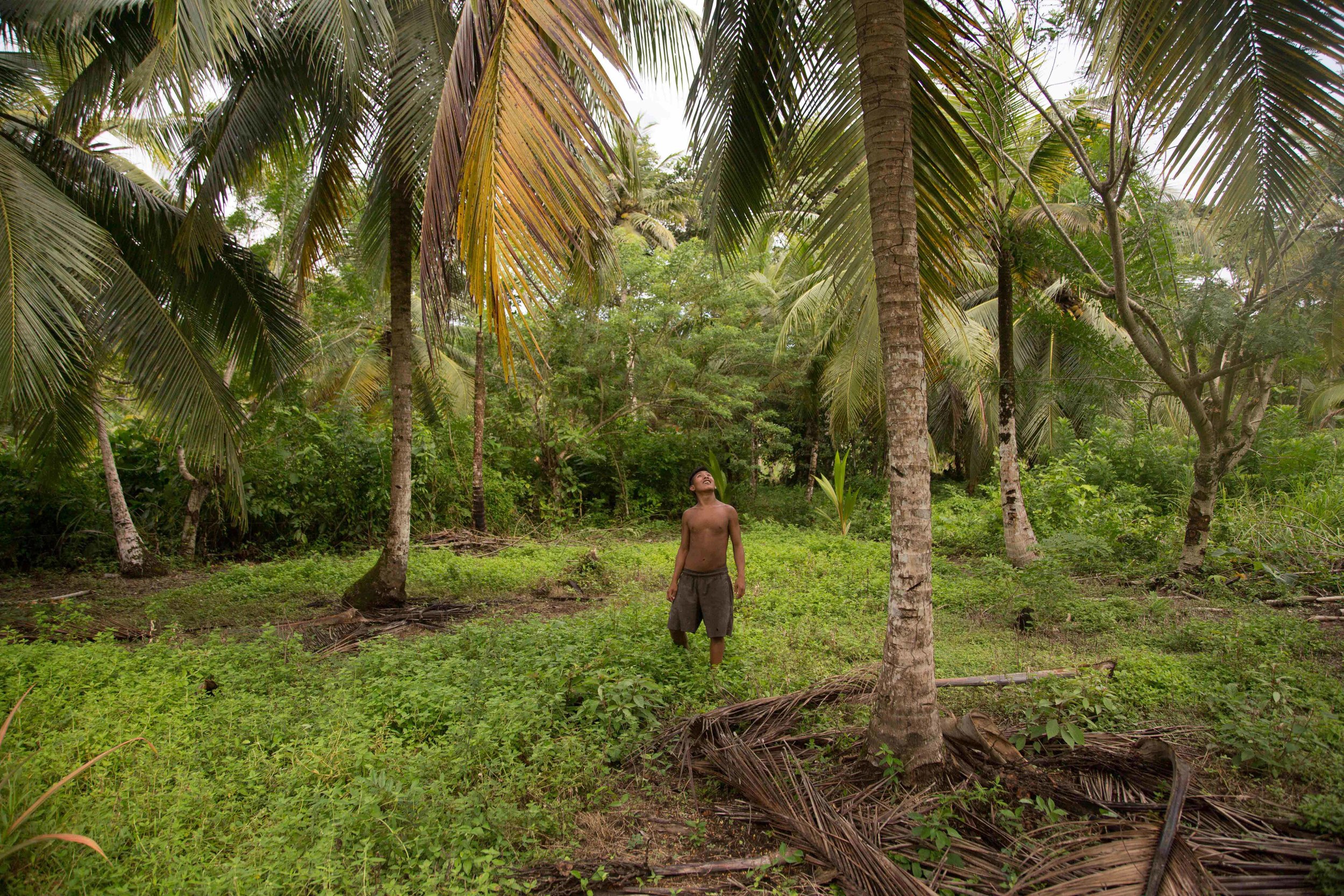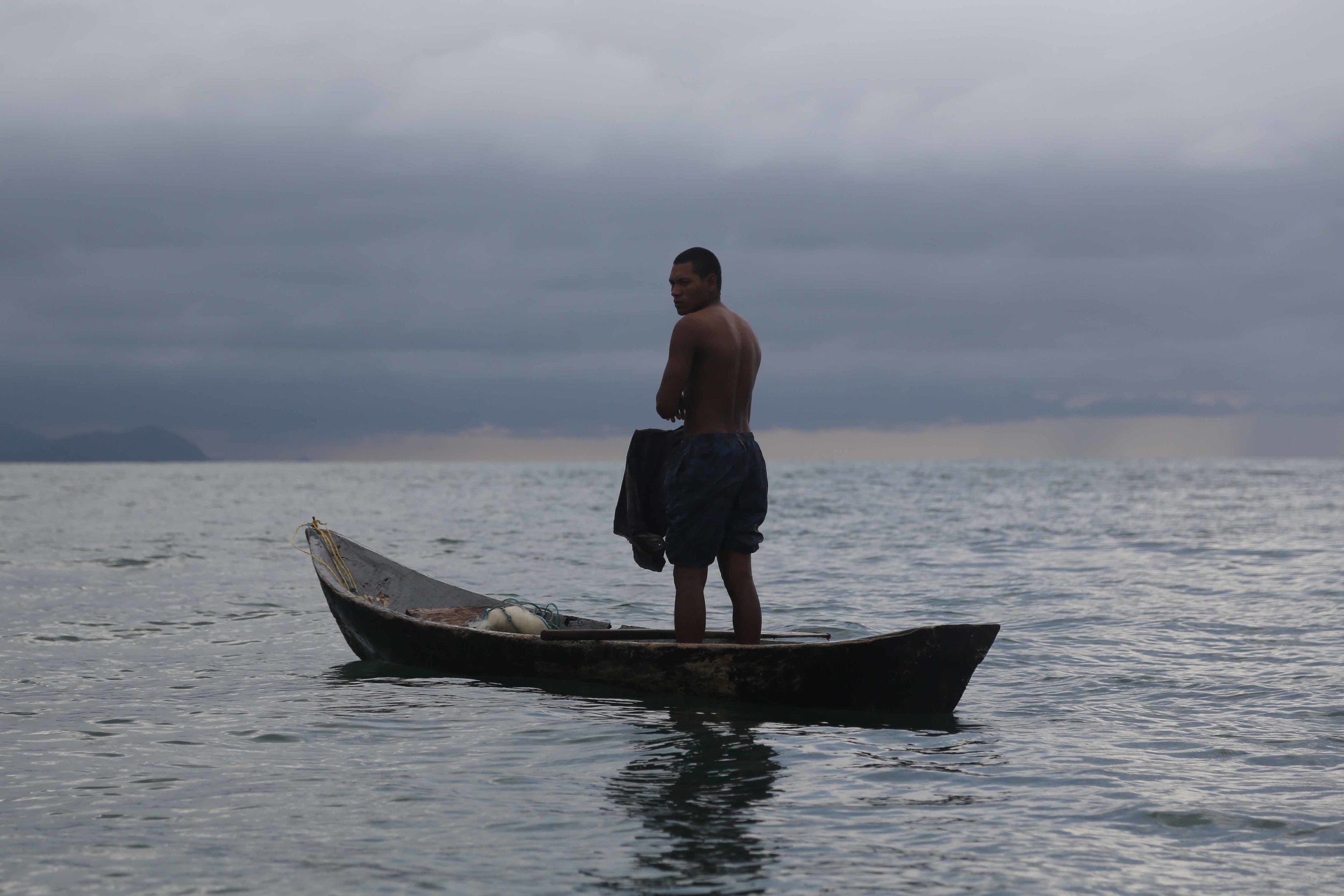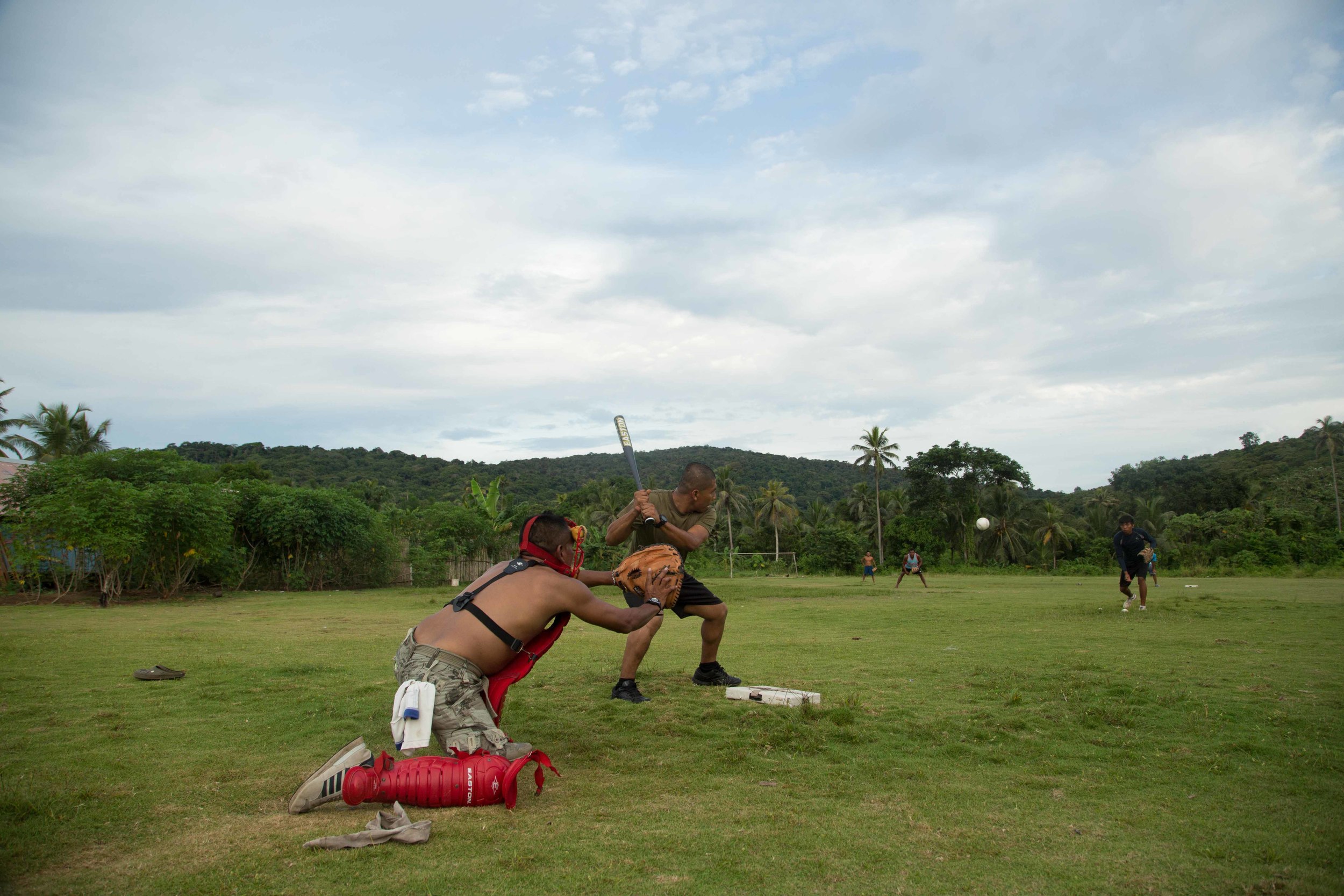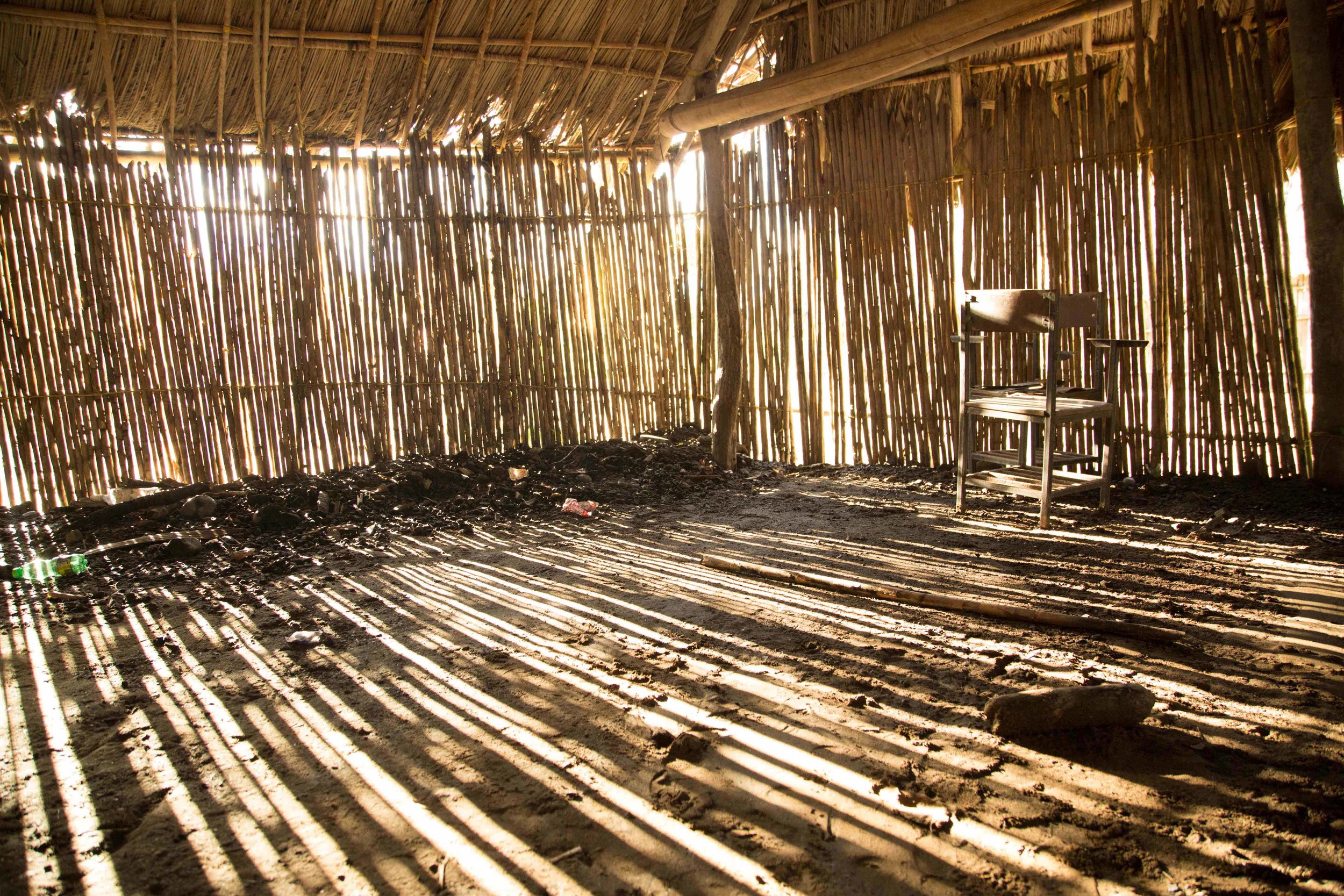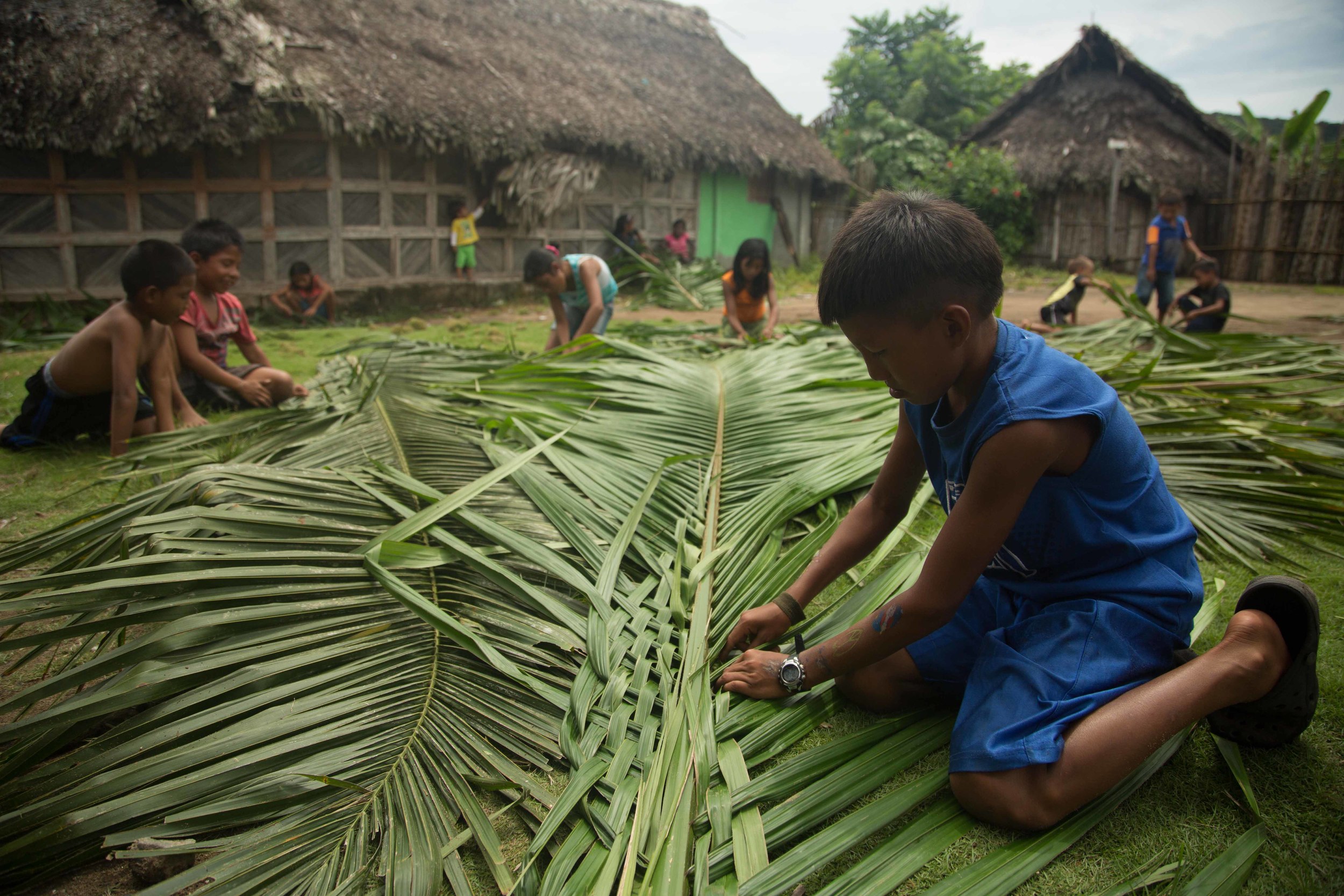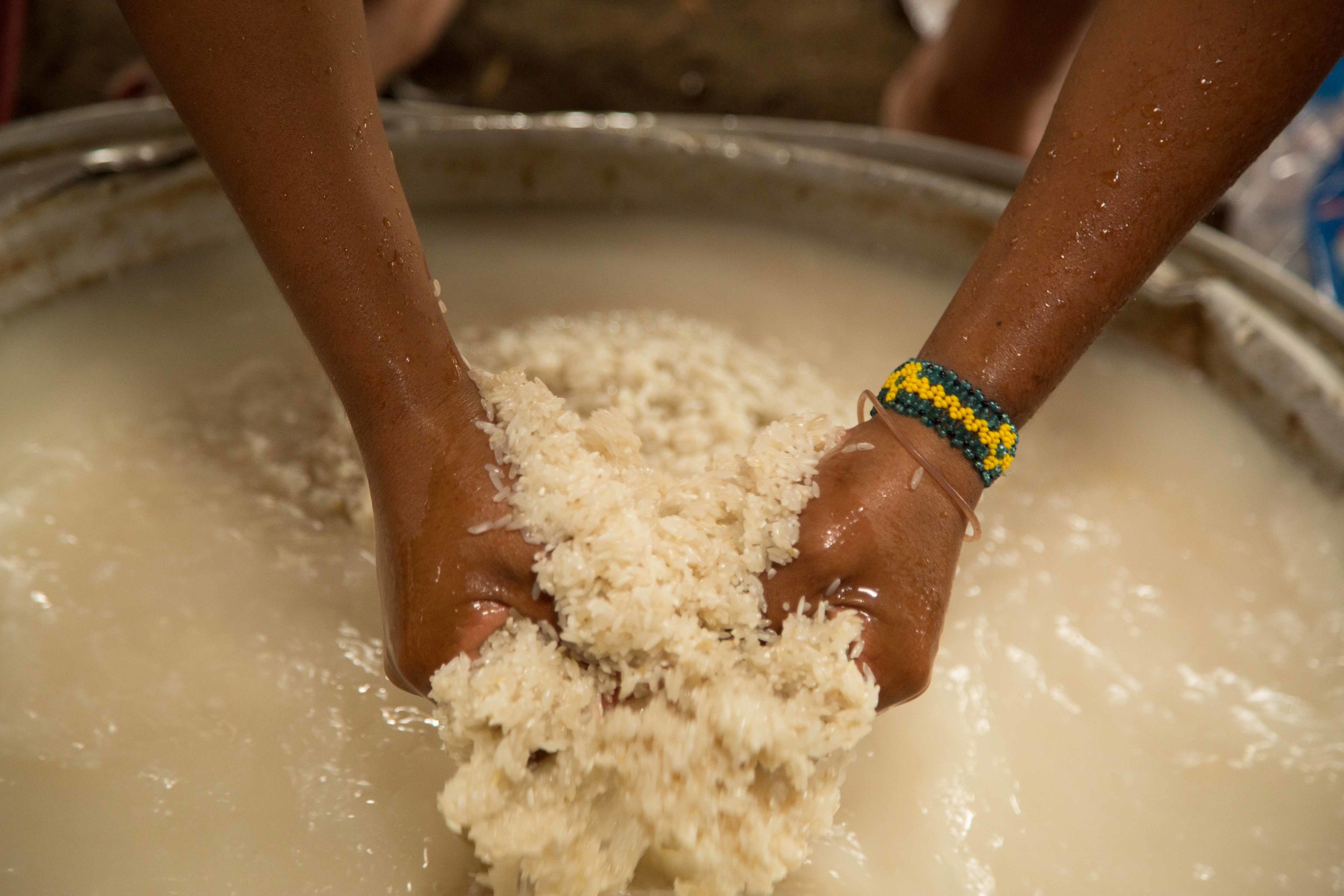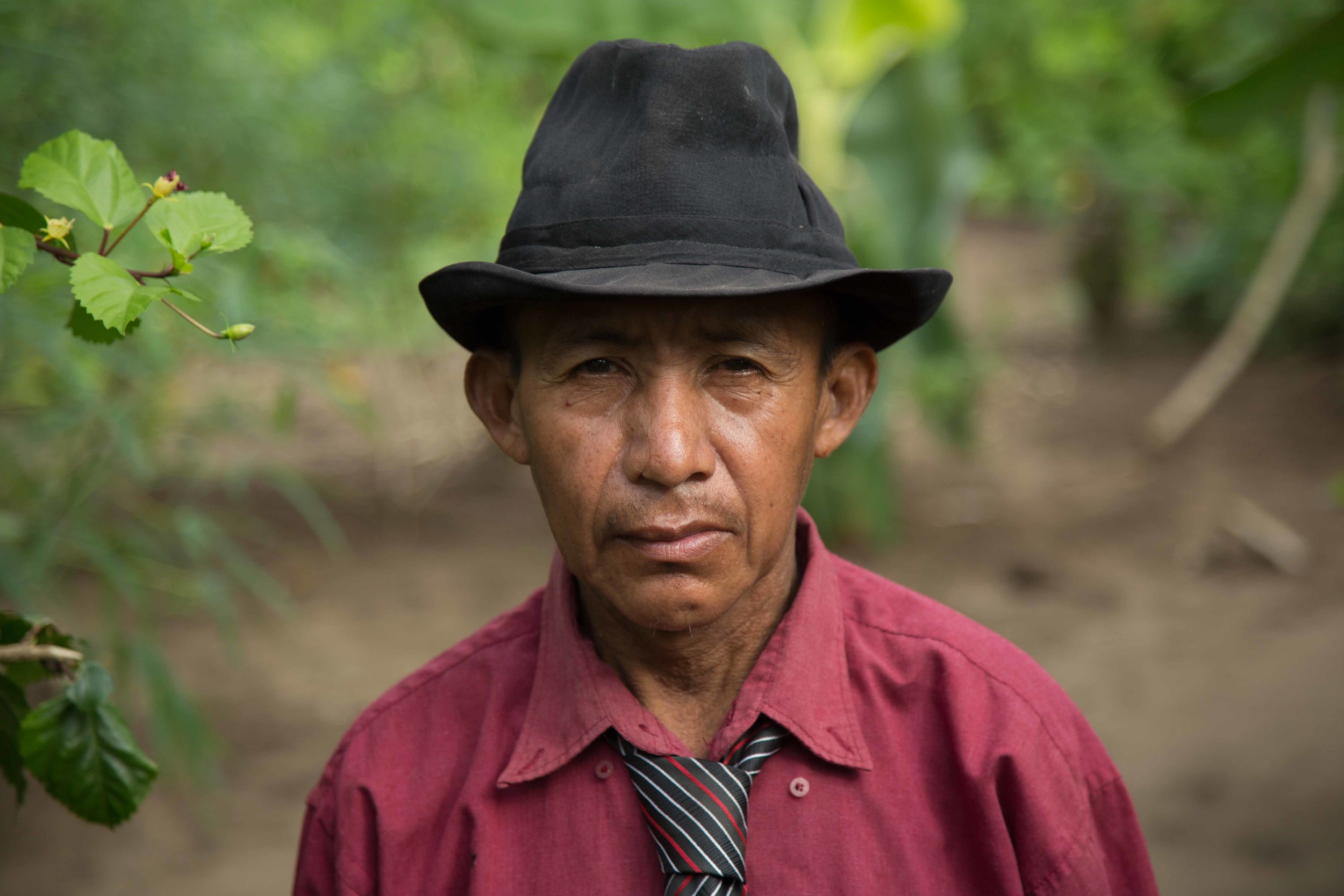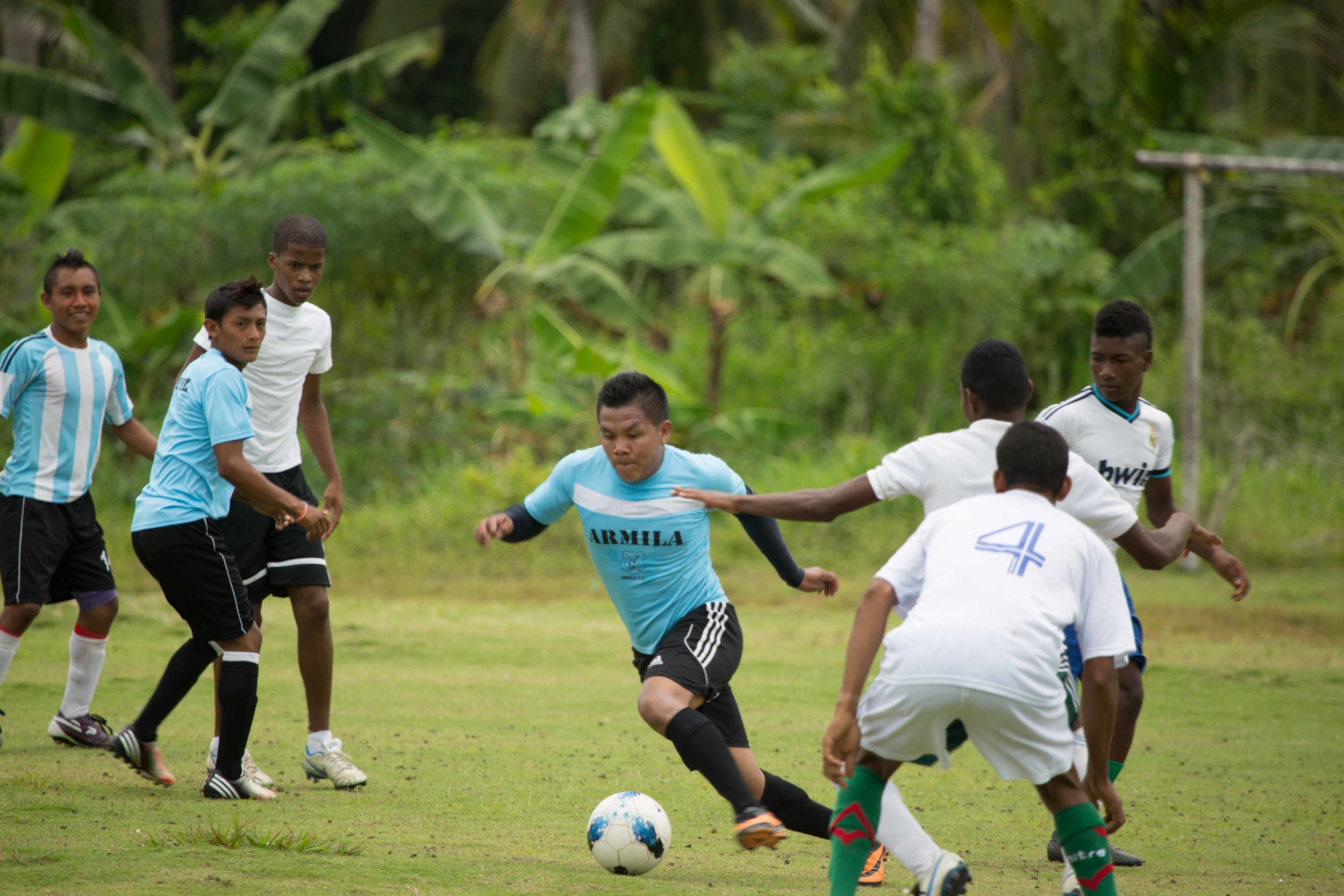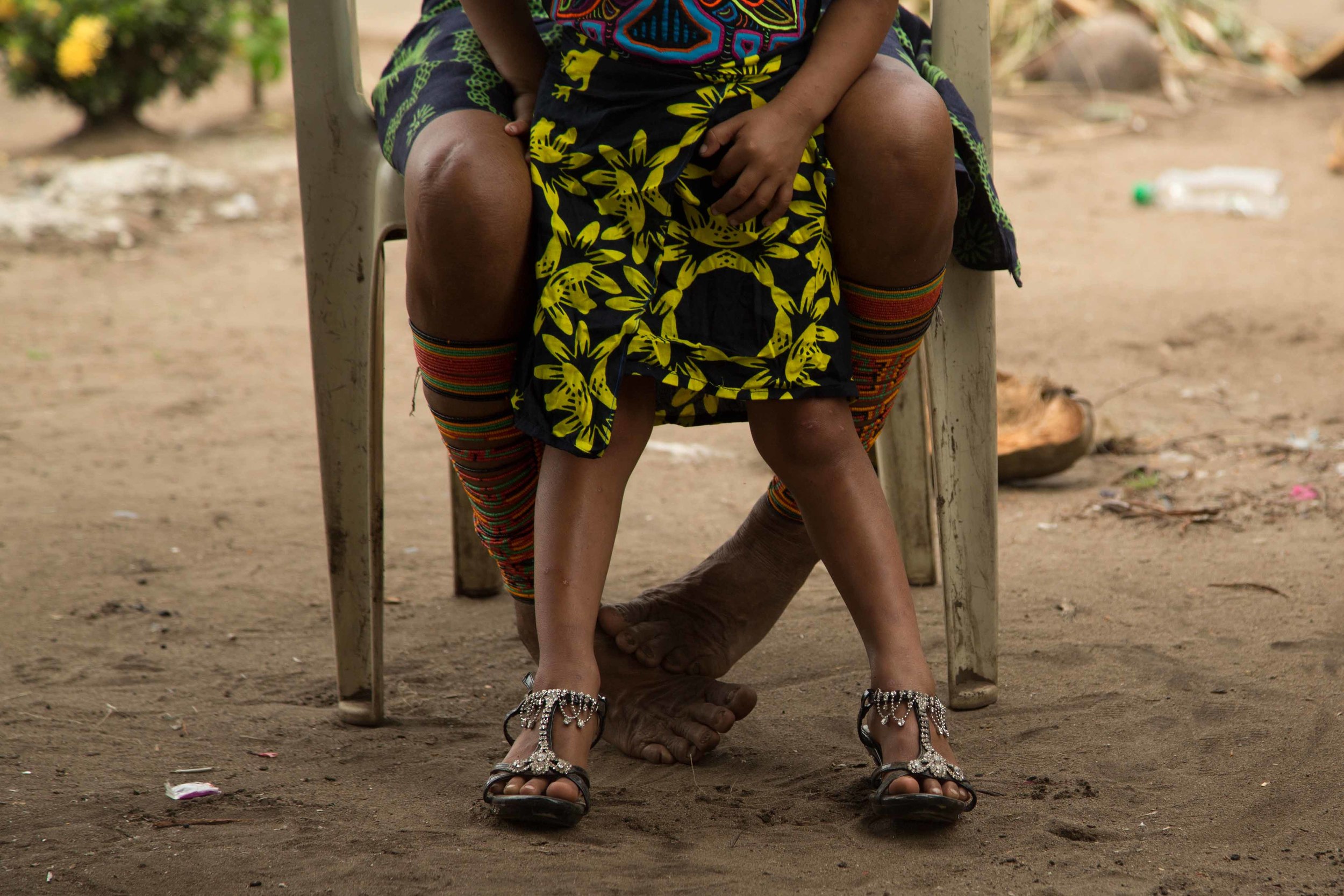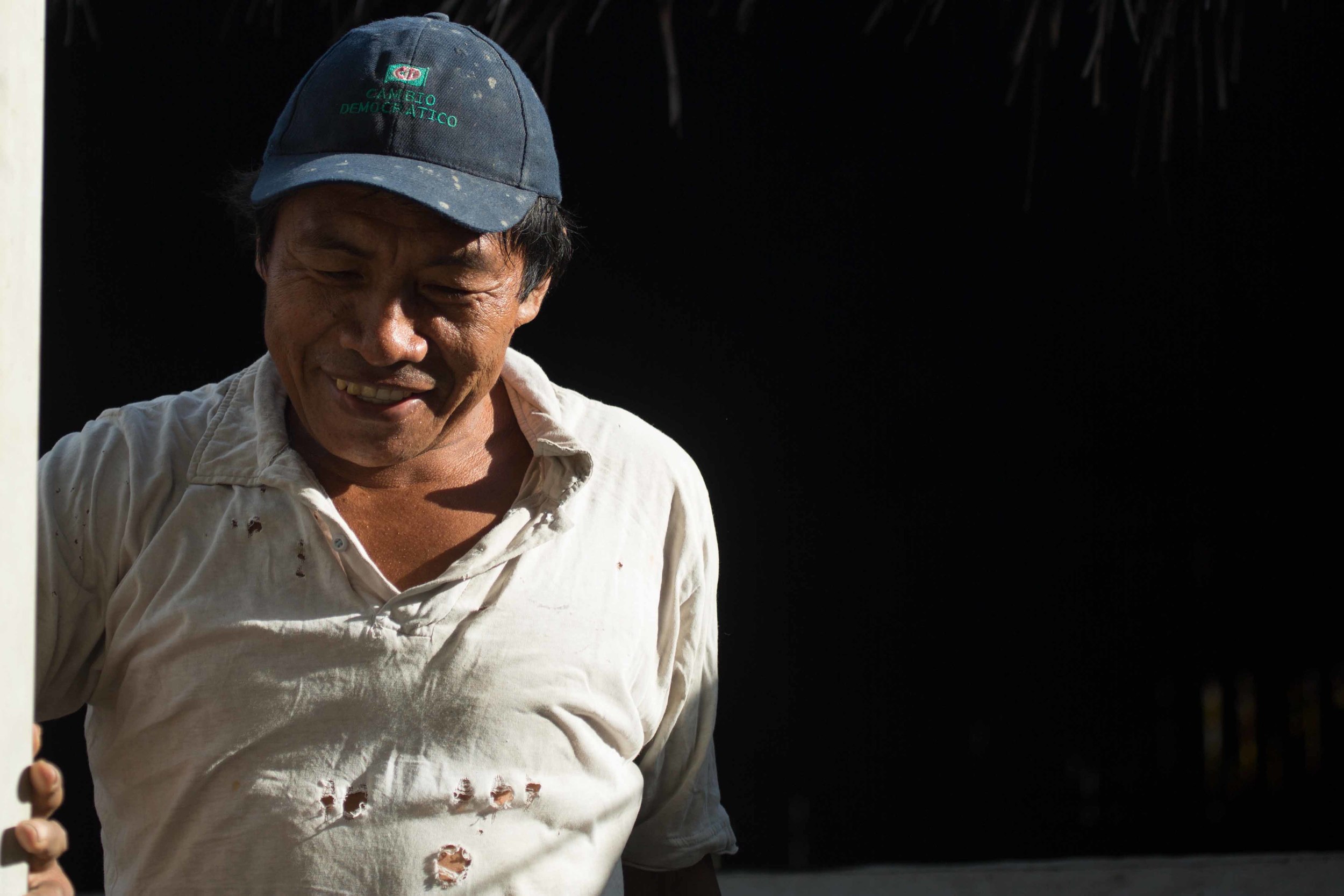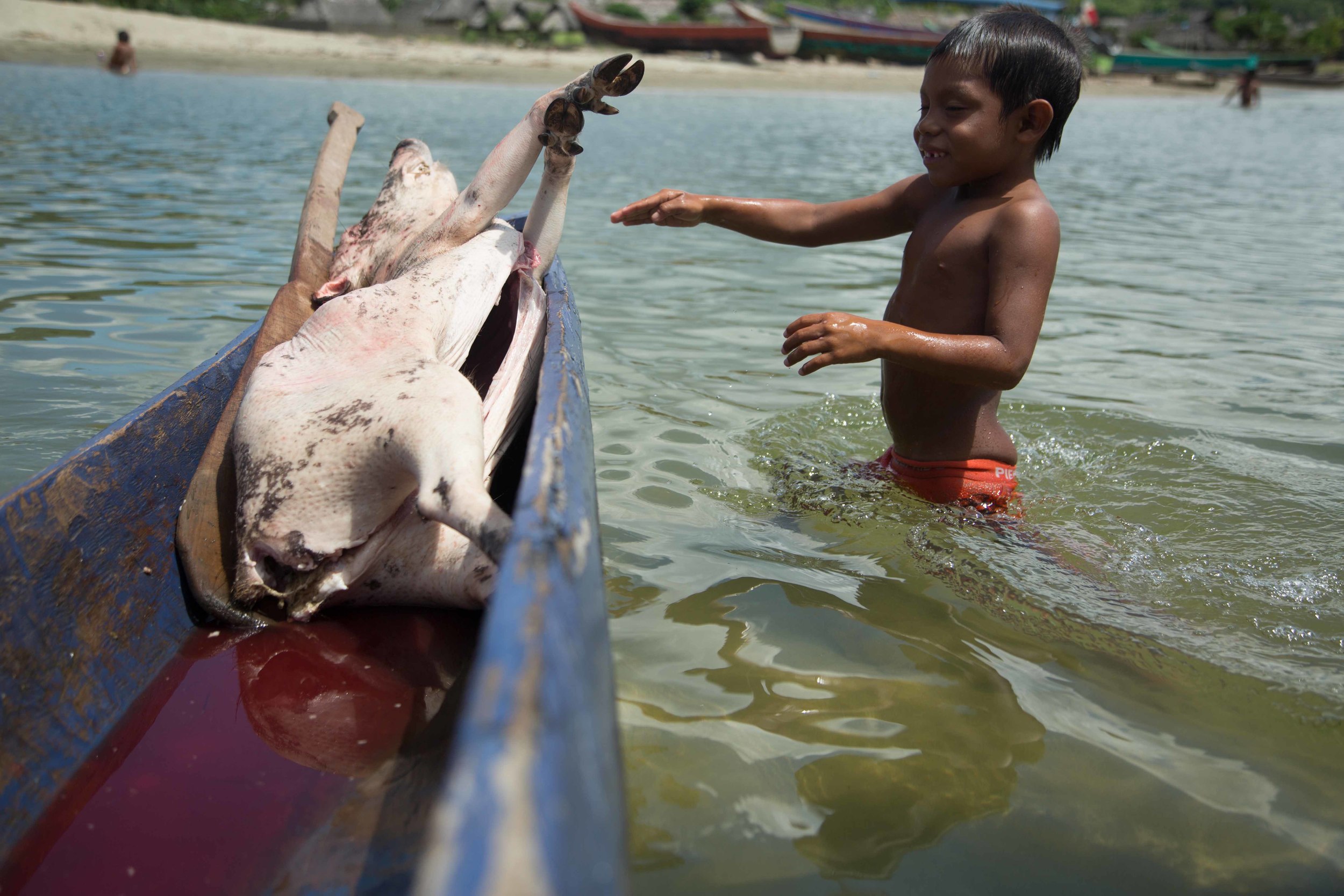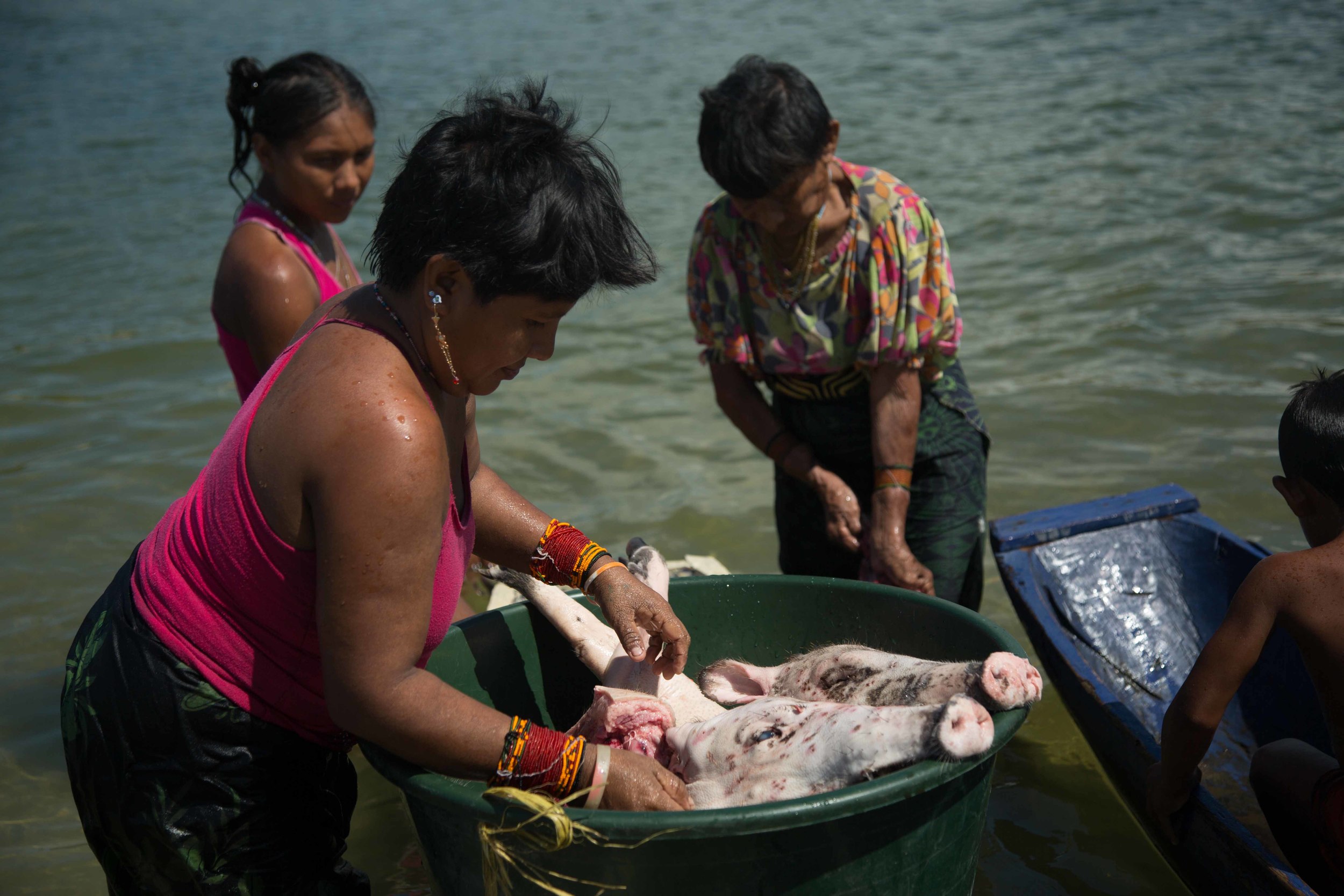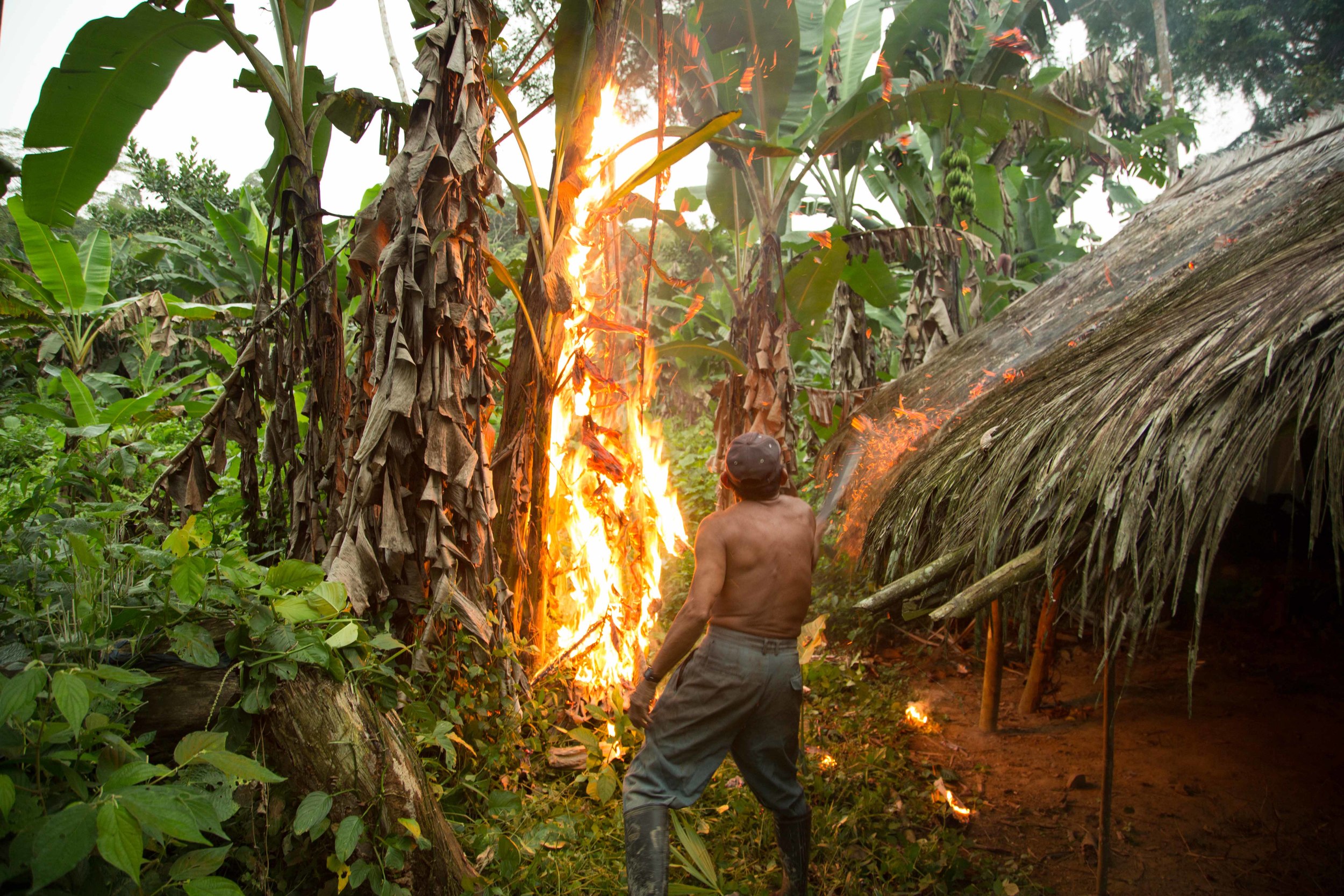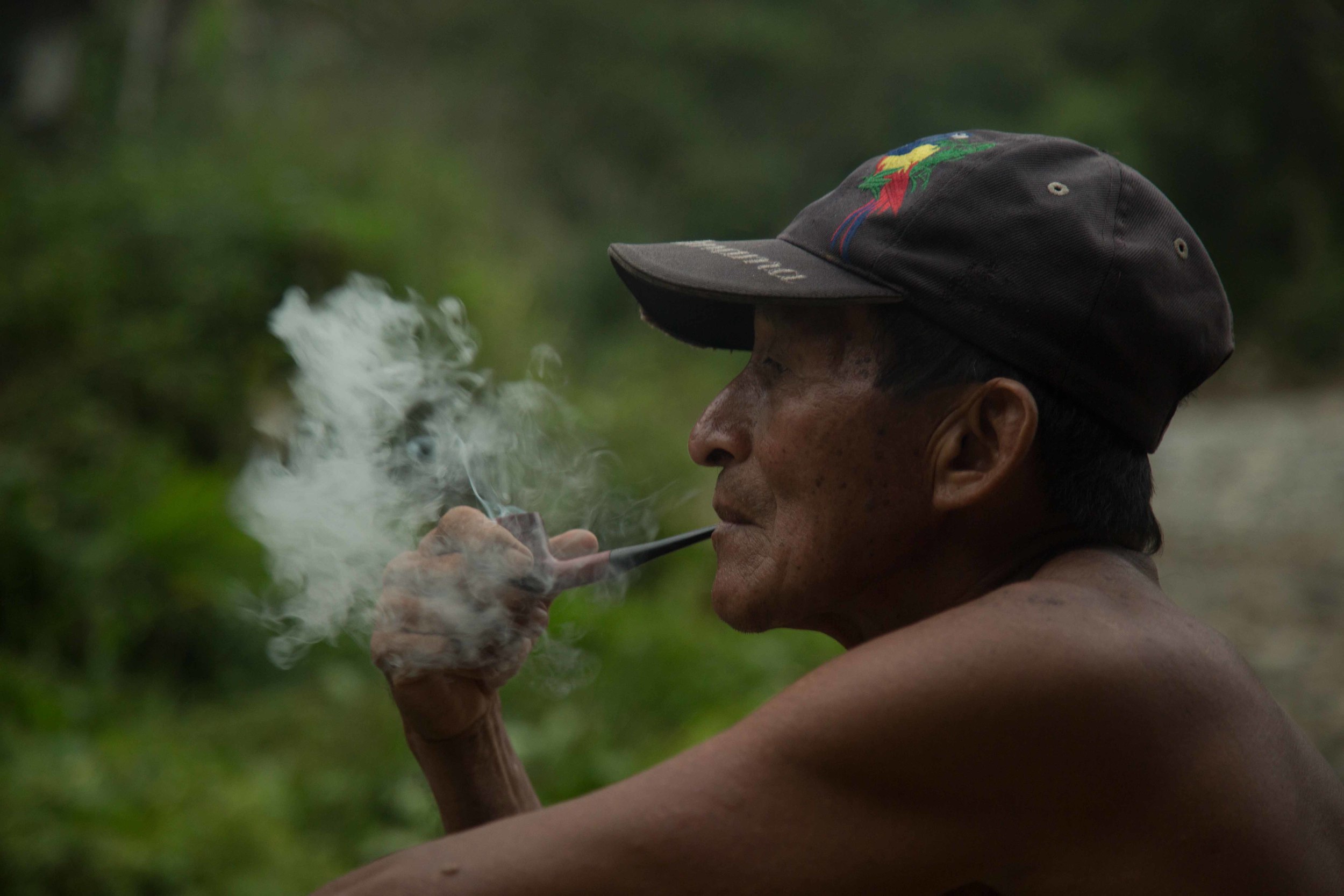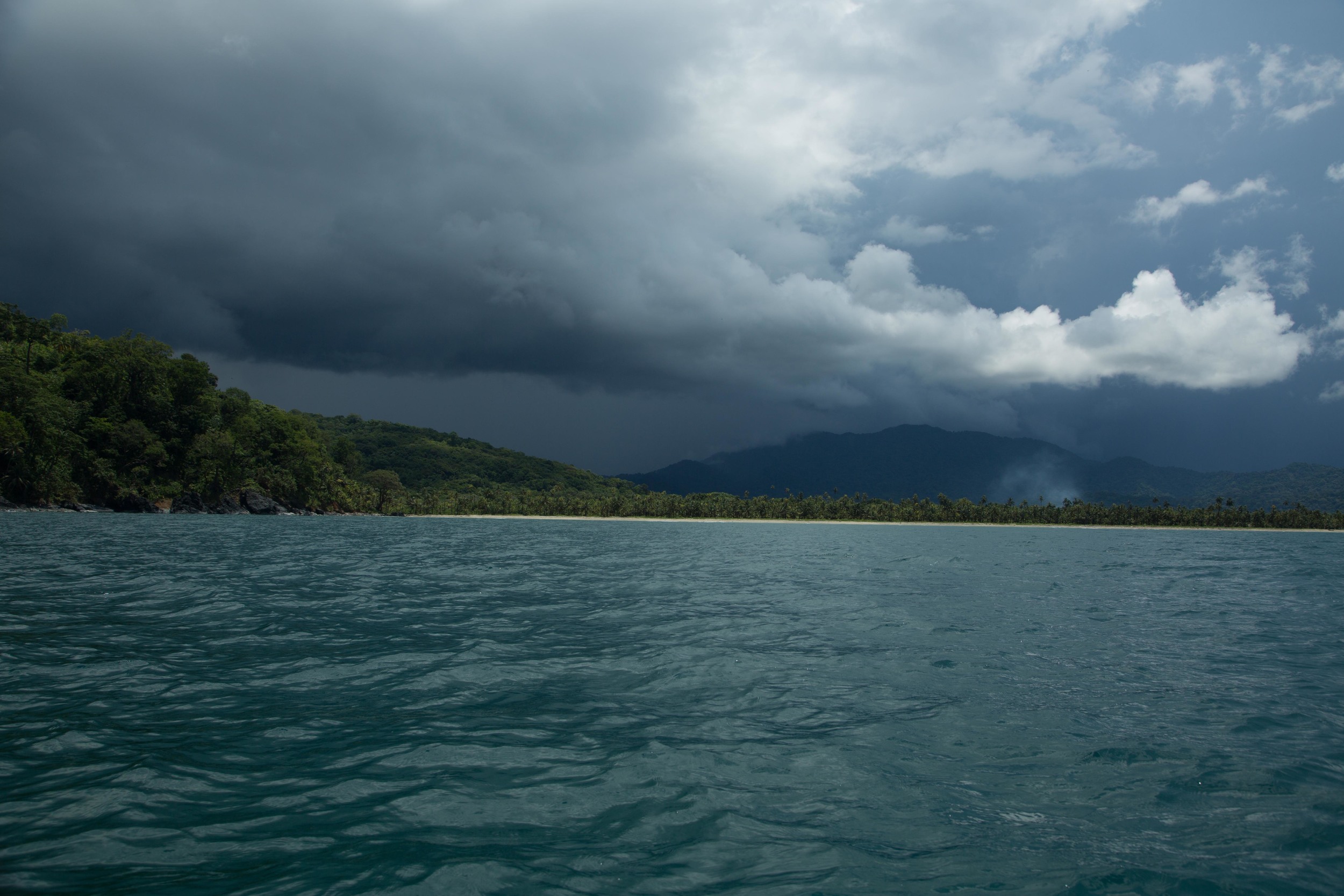At 6:30 every morning, Fernando drags his 12’ homemade dugout canoe from the shore into the chilly water of the Armila River – named after the village he lives in. He paddles through a thicket of long reeds along the bank; they caress the hull and make hypnotic swish-swishing noises to accompany the soft crashing in the distance, where the river meets the Caribbean.
He lands at the mouth to dig up bait. It doesn’t take long to find a crab hole on the beach. His fingers enter the sand with ease, bringing up piles and piles, which he throws behind him. “Ya salio,” he says. The crab must have left for a morning snack. I notice three craters on his left shoulder - vaccine scars.
When Fernando finds a crab, he handles it with ease. It takes seconds for him to crunchily twist off the claws and legs. “I do this. I do that. Okay, ready,” he says, presenting the limbless, helpless thorax to my lens. Its eyes are still moving.
Back to the boat.
With help from a friend, Fernando launches the canoe – with me in it – out through the surf. I bounce on the chop and can’t help exclaiming “Oh shit! Oh shit!” The Canon 5dMiii I’m wielding is borrowed from The Corcoran College of Art + Design – but at least it’s insured.
Fernando’s arms and abdomen are muscular from years of paddling. His hands are calloused, his skin bronzed from the sun. Like every Guna man I’ve met, he has no body hair and his facial hair is sparse. His hair and features are dark, though some Guna men have blonde hair to match pale-pink skin. Albinism runs much more common in Guna blood than outside the region.
Fernando smiles wide when he snags his first fish, revealing a missing upper bicuspid.
“Ya estamos super bien,” he says – we’re doing very well.
“I only caught the crab to catch this fish,” he continues, referring to a specific fish species that isn’t eaten by people, but loves crabmeat and works wonders as bait for bigger fish. He sets his paddle across the canoe and uses it as his carving board. I feel for the fish as the knife carves through its scales; it sounds like high-grit sandpaper against a rough 2x4.
We’re not the first ones out on the water and we won’t stay the longest time, but Fernando catches more fish than any of the other dozen or so fishermen. When a wave crashes into the canoe, (at the time, Fernando was busy talking to a passing angler) flooding the cabin and carrying off 10 of Fernando’s catch, he still comes home with 35, 15 more than two of the other fishermen I surveyed.
Luckily my lanky arms were extended, holding the camera 3 inches above the wave’s crest – the lens and body were the only things to come out of the accident dry.
Fernando caught every fish I ate throughout my stay in Armila. He’d hook it in the morning or during his second venture around dusk, give it to his aunt, Gladys, free of charge, who would deep-fry or boil it for me. I’m lucky. Some Armilans only have the money to eat a plate of rice and uncooked tulip – the Latin American version of Spam – for dinner.
Fernando's attitude and thirst for success are contagious – I want him to catch and gut enough to feed his family and the village.
The beauty of Armila hits you immediately. The sunrises over the cloudy ocean during the rainy season provide glorious seascape gradients between navy blue and gold. Pull a 180 and you see a sea of every imaginable shade of green in the forest. Even after a prolonged stay, surprises jump out and bite. I went days before seeing my first bright green striped lizard, a couple weeks before my first emerald hummingbird.
From a 20-foot tower next to the 4-room elementary school, you can look out over the entire town. Thatched grass roofs are punctuated by corrugated aluminum and concrete. More and more families are moving into homes built from modern materials.
Just as striking as the beauty is the tragic state of Armila’s beaches. Plastic. Plastic. Plastic. It comes in on boats wrapped around cigarette packages, topping soda bottles, or molded into green lawn chairs. It lives on Armila’s beaches in every form imaginable, going on into the horizon in both directions, some broken down to microscopic granules, begging to be washed out and eaten by Fernando’s fish.
It’s a burden on the budding tourism industry and a threat for the environment – nesting leatherbacks (a vulnerable species on to the IUCN red list) will turn around and forego laying their eggs if there’s too much foliage or trash on the beach. It’s a public health hazard – fish eat the plastic, people eat the fish, women breastfeed their infants, everyone tastes cancer.
At 7:00, Principal Lebio rings the bell to beckon students to class. He slams a fist-sized stone against an oxygen tank hanging from the rafters 14 times and tosses the rock to the ground.
Students arrive at a trickle. Most wear spotless uniforms – navy pants or skirts; a white or powder blue button up and black patent leather shoes. Some adorn colorful molas – traditional Guna blouses with intricate appliquéd patterns and designs. Middle school-aged boys stand in groups like skulking hyenas. Young girls dig in the sand, twirl and chase each other. One agent of chaos, a boy no older than seven, runs around carrying string and trying to clothesline girls. Other boys, maybe the girls’ cousins or brothers, confront him and a fight is narrowly avoided.
I feel nostalgia for the playground.
There are three school buildings in Armila – one for pre-kinder and kindergarten, one for elementary school and one for middle and high school-aged students. They’re spread all over town. All three have blue corrugated aluminum roofs that slick the rain into neat sandy trenches during the daily downpour. Kids learn to read in their native tongue as well as Spanish. They learn art, algebra, history, music, physical education, and have practical farming classes.
The high school English teacher’s specialty is painting; the government placed him in Guna Yala and gave him an impossible assignment: learn and teach high school-level English simultaneously. Not one of his students can recite the alphabet, but they copy word-for-word full paragraphs about Panamanian history. They haven’t learned English consistently leading up to this grade (they're all about 16), so they can’t understand or speak in full sentences. At this point, they should be reading “See Spot Run.” I hide my surprise at the astonishing waste of everyone's time.
A half-kilometer away, men row upriver into the rainforest and land in a parking lot of canoes. It’s time for the biannual path cleaning, where every able-bodied man takes his machete to beat back the bush and clear the walkways leading to plantain and banana farms. If you don’t beat the bush, you pay a tax - $5.
Everyone dons the workman’s uniform: black, knobby knee-high rubber boots with aggressive butter-yellow soles, jeans or denim shorts and a rugged shirt. I stand out in my khaki-colored anglers’ boots that only reach mid-calf, khaki pants and a thin jersey used for ultimate Frisbee.
Shing! Shing! Shuck! Shuck! I stay out of the way without stepping too deep into the rainforest. I swat at buzzing skeeters between shooting video.
Tigre (real name: Benjamin) gives me his machete to whack back some foliage. As I hit a thicket of twisty thorns and ivy-like vines, the blade turns downward and thumps the ground. Laughter from the veteran machete wielders, led by Tigre. Again and again, I fail to slice gracefully. More laughter. It’s okay. I’m used to it – even my nickname evokes laughter from the locals. “Elliot” is too difficult to pronounce; somehow it always ends with an “s” when stated by the Guna tongue. They call me Mergi. It means gringo, outsider; it’s a permutation of the word ‘American.’
Benjamin "Tigre" Martinez with his wife and two of his grandchildren.
Tigre (Spanish for tiger) got his nickname from his many lives: according to legend, he’s been in more than 10 boating accidents in which the boat flipped – and lived through all of them. He’s in his mid-50s with the body of a 25-year-old crossfit instructor. He farms, he hunts, he has a dozen grandchildren. He’s boisterous and friendly. He’s diplomatic. He’s big on the town’s laws and regulations. He’s a rising candidate for sahila (lpronounced si-lah with the 'i' of 'silo') – village elder.
There are seven sahilas in Armila. They hold religious services three times a week, in which they chant for long, beautiful stretches in Dulegaya, (Pronounced too-leh-guy-uh. What the Guna call their dialect, it literally translates to ‘people tongue’) repeating phrases over and over with slight variations to make long, musical stories that depict animals and nature in their metaphors for life lessons. The sahilas punctuate each chant with an interpretation and application for everyday life. Afterwards, village disputes are brought to light. Sometimes the drama reaches Jerry Springer levels. In one instance, an albino woman had a spat with her mom regarding a short-lived marriage. The mother had apparently told her daughter’s new husband he should leave her because he was visibly unhappy. After an exchange of shouting and dramatic gestures, the slighted woman left to patters of chuckling from everyone else.
Around 11:00, a 30-minute walk into the rainforest, Manuel Ortega plucks fern fronds from the ground and stuffs them into a seafoam green plastic back, which he replaces into his knitted rope backpack and slings over his right shoulder. He moves slowly, which is unfortunate, because mosquitos buzz up every few meters and go straight for the sweaty Mergi.
“Mucho mosquitos. Ha ha!” Manuel croaks. He mixes his Spanish with his Dulegaya, but I catch phrases here and there. A lot of mosquitos, he said.
“Yes,” I think. “Hadn’t noticed.”
He picks up and explains the medical uses of dozens of plants. One for backache. One for AIDS. One to brew and wear like cologne that would make even the cruelest professor enjoy your company. He chants in Dulegaya for seven minutes over a brown, boiled brew made from various plants we collect that day before delivering it to his patient.
Manuel is another rising candidate for sahila. He has practiced traditional Guna medicine for over 50 years and brags about its advantages over Western medicine.
He recalls a story of a Panamanian soldier who suffered fractures in his tibia so severe that all white-coat doctors could prescribe was amputation. The soldier wouldn’t accept it. He traveled to Guna Yala, received care from a medicine man and within 6 months had made a full recovery. I hide my skepticism for the time being, but later see Guna medicine fill a void that Western medicine left painfully open.
Morrison Mast, a longtime friend and colleague, arrived with his girlfriend and work partner, Amanda Gibson, about halfway into my 10-week visit to Armila. Morrison knew the town and region well, (he had been the one to originally introduce me around and show me the ropes a few months earlier) but on his first day back, he made a rookie mistake – he approached an overly friendly dog named Bingo. Yes, Bingo’s owner is a farmer. Thirsty for affection, Bingo hurdled herself paws first at Morrison, scratching the flesh just outside his left cornea. She left a tiny scrape that bled into the rest of the eye. His new nickname became “Achu Ibya,” literally “Dog Eye.” I encouraged everyone in the village to use it liberally.
In addition to the slowly growing blood pool, the white part of Morrison's eye eventually bruised to ominous shades of purple and red.
“If I could just access WebMD or Wikipedia, I could solve this myself,” he said after the second day of worsening. Western medicine couldn’t help Morrison – they didn’t have the tools or antibiotic drops in this part of Guna Yala – so he approached a medicine man (not Manuel, there are others in the village), who prescribed him a pot full of blood-red juice to pour over his eye as often as he could (I was told it was brewed from leafcutter ants). He was prohibited from sex, alcohol and standing in direct sunlight for longer than a few minutes. For three days he carried around the pot, scooped up handfuls of ant-juice and splashed it into his ibya. Within two days, his eye was noticeably better. After a couple more, he received a new kind of eyebath – a brew as black as crude oil, but not nearly as viscous. Within two more days of eye bathing and abstinence, his eye recovered completely. Science. Guna science.
During his recovery, two dogs attacked Morrison’s leg as he entered a friend's hut and drew blood. Achu Ibya was then used interchangeably with Achu Mali, “Dog Leg.” He swallowed amoxicillin for a week for that wound.
Between 8:00 and 11:00, dozens of people filter through the 60’x30’ onmaked nega (gathering house). At least 30 occupy it all the time. At the height of the morning's events, men wield 10’ bamboo poles with baskets on the end, frothing boiling mixtures inside large, fire-lit cauldrons by dunking the baskets in and out. Someone plays loud Latin music over a radio. Women chat and chatter and giggle and shriek; two ladle an oatmeal-like snack into bowls for everyone.
“Bailibbe! Idilio! Olo!” A man calls volunteers to take their shifts with the baskets.
Chicha fuerte, literally “strong juice,” is a Guna tradition on par with a PTA potluck, only drunker. The entire community comes together to collect, cook and later drink the fermented beverage.
The men collect cane sugar, squeeze the juices from the pulpy stocks and pour it through colanders into seven massive black cauldrons. Women collect and place firewood at the bases of each one, prepping to boil the concoctions. They brandish woven reed hand-fans to stoke the fires. I get too close and melt my tripod’s red rubber feet into the sandy floor. Everyone is sweating; steam fogs up my lens.
Tigre sits in the corner on a bench with other older men. “You have to test it to see if it’s sweet or salty,” he laughs. He’s happy to partake in this job, using gourd-like bowls to mix and cool the blend before tasting.
After cooling the batches it in bowls resembling oversized prospector sieves, the brown-black liquid is poured into two red clay pots, covered with banana leaves and buried. It takes one to two weeks for the chicha to ferment.
A week later at 15:30, Tigre carries out his duties as the village sommelier. “We’ll start with this pot,” he says, gesturing to the pot closest to us. “It’s stronger than the other one.”
“You can tell if it’s ready by the bubbles that hit your throat."
We don headlamps as another crusty senior excavates the covered pots. The banana leaves have dried and make crispy sounds when they’re removed. They reveal the sides and lip of the giant chicha pot. Roaches scatter. I’m handed a bowl and take a few sips – it’s like a carbonated dessert wine – half Manishewitz, half liquified dark chocolate, full-on seltzer. It tastes better after your fourth gourd.
At 21:30, I sit on a bench and listen to sounds of screaming, cheering and chugging. Pan flutes and stomping feat give a familiar rhythm to the onmaked nega - I spent a couple months shooting and editing a documentary about Gammibe Gun Galu, Armila's musical dance group.
We sit around the perimeter in benches, leaving the center of the hut open. Men and women drink on opposite sides of the room. The women pass around gourds. Sip, pass. Sip, pass. It’s subdued, stolid. I’ve been instructed not to film the women after they start drinking – it’s not proper to record inebriated females.
The men's style is different. We collect in groups of ten, each with a full gourd in hand. We whoop; we shuffle; we whoop some more. We chug in unison. I open my throat to keep from being the last one drinking. We throw them back in the community bowl for the next group. The action and sounds are camera-friendly, unlike the horrible lighting - two incandescent bulbs light the entire hut. We’re probably 50 men in total, aged from 17 to 70.
I’m a lightweight. I finish my seventh (no, eighth?) gourd. I stumble back to my seat next to my tripod and attempt a few pans of the boys sitting opposite me and check the levels of my sound recorder.
A string is placed to keep her septum piercing open. When she's old enough, she'll decide for herself whether to wear the traditional ring and beads, winni.
Chicha drinking accompanies village milestones: the leader of the local musical dance group brings his infant daughter in. It’s a big day – time for her septum piercing. She’s paraded around and taken into a makeshift room, lit by candles with sheets for walls. It’s over in seconds with no screams.
Afterward, men and women toot pan flutes, shake maracas and dance in unison.
30 minutes later, I’m in my hammock, losing a fight with the spins. It eventually turns into a fight with the bends. Chicha tastes much better unaccompanied by bile.
I was incredibly lucky to witness and participate in and film the chicha tradition, but tradition is a double-edged sword.
In their desire to provide alternative protein sources for Armilans so they would never have to resort to leatherback poaching or egg hunting, Morrison and Amanda raised money for the construction of tilapia tanks in the town. Cue the ominous music.
Fish is a big industry in Armila – at least a dozen men make a living selling fish to the rest of the village. Some of these men may not have another source of income – no farm, no livestock and no crafts to sell to mergis. Some saw a convenient source of fish as a threat to their wellbeing. Compounding the problem, one Armilan man claimed the tanks as ‘his project,’ causing others to think only he, rather than the community, would profit off of selling the fish. These issues were discussed in community meetings for weeks. People brought up the issue of mosquitos, that the tanks would give the disease-carrying insects new places to breed and lay eggs - which isn’t really true. It was argued ad nauseum – and still the sahilas were pro-tanks. About a month into my stay, the debate came to a grinding halt.
Sometimes stories write themselves.
An individual – who never came forward or was identified by name – saw a demon come out of one of the half-finished tanks. Or maybe it was two demons. It was never clear.
This is problematic because it meshes with Guna tradition that disturbing the ground – say to prospect for gold or bury trash – can disrupt other planes of reality. Despite many Armilans identifying themselves as Christians, there is still a strong animistic influence in religious life. Rocks, sticks and carved idols are used to ward off evil spirits. Still, most of the people I talked to were skeptical; the sahila whose land the tanks were on was outright incredulous.
On top of the demon issue, Armila was dealing with a particularly bad mosquito season. Rumors of blistering ankles that leaked pus foamed up through the floorboards, though I never saw anyone other than myself who was dealing with mosquito bites too horrendous.
How do the Guna deal with these matters? They call in a shaman.
Tigre briefly explained to me the folklore and mystique that surrounds shamanism. A shaman – nele, in tulegaya – is always born to a mother who dies in childbirth (though if your mom dies in childbirth that doesn’t necessarily make you a shaman). He can predict deaths. He can speak with spirits. He can tell if demons have truly appeared or not. He charges $600 for this particular consultation service.
If the shaman determined that there was indeed a demonic presence, the town would rid itself of evil spirits and mosquitos with a pipe smoking ceremony. This ceremony is problematic for outsiders – I felt the wrong end of the double-edged sword approaching my throat.
Every non-participant was to evacuate the premises for the entire ceremony – this meant all non-indigenous people. Teachers from outside the region were given vacation. Special tobacco and pipes were purchased. Arrangements were made for women and men to sleep in communal, gender-segregated homes (opposite sexes weren’t to see each other during the ceremony). No one could speak a word in Armila louder than a whisper during the ceremony. No one could wear shoes, because it made too much noise and the town was holy ground. Generators were prohibited for the same reason – so no TV, lights, or refrigeration. Families built makeshift homes on the beach on the opposite side of the river, where women and children would spend their days cooking and playing.
Even before the nele came to examine the tanks, the ceremony was moving forward by default. All the time taken to prepare was too heavy an investment for a non-starter – people would be furious if it didn’t happen. Families spent days shuttling supplies and building materials across the river on canoes. They claimed and cleaned plots. Others prepared to leave for the period and pay the $200 fine for not participating.
It was a blessing and a curse. It was the last two weeks of my visit, the most critical period for filming. I had momentum. I had a shot list. I wasn’t sure if what I had was enough. But I was also waking up every morning with rat feces on my mosquito net directly above my face. I wore sandals in the frigid shower to avoid stepping on more rat excrement. Between the heat, limited diet and lugging my equipment around eight hours a day, I had lost 20 pounds in six weeks. I was tired of bony fish and canned tuna. It was also an opportunity to review and log my 600 gigabytes of footage.
I left with Morrison and Amanda to cross the border and stay in a sleepy, touristy Colombian town called Capurganá. Hot showers. American portions. Internet.
Too much of that two-week period was spent stressing about when I could return to Armila to finish shooting; I didn’t go back until the same day of my returning flight to Panama City, and only did so to retrieve my equipment and say a few goodbyes.
For the record, I did have enough footage, but not everything I want. There's more to document.
Roughly half the Guna population lives outside Guna Yala, many in Panama City or Colón. Armila is one of the few remaining towns in the region that comes together as a community to build homes out of materials gathered from the forest that surrounds them.
When Morrison and I asked sahila Esterbino Evans about the growing Western influences, he said, “It’s no longer the time of the Guna. It’s the time of the school system, of the Latino.”

